




Welcome to the Autumn issue of Real Farmer, where we reflect on the summer season and prepare for the years’ cooler months.
We hope that everyone had a wonderful Christmas and New Year, managing to find some time to relax with loved ones and take a break from the farm.
In this issue of Real Farmer, we chat to the presidents of the Methven and Mayfield A&P Shows to discover what’s on the agenda for this year’s shows while commemorating the significance these shows present to local and farming communities.
We step on farm with former contract milker Michael Schat, who gave up dairy farming to rear Red Wagyu beef in Aylesbury in partnership with Southern Stations Wagyu, in their 1250-head composting feed barn.
We also look back on the farming year, reflecting on the successes and failures of what has been a turbulent 12 months, and consider the forecast for the agricultural industry.
And lastly, we bring you new ideas on how to keep your home cosy as the weather cools, including seasonal styling tips and recipes that will warm your belly and soul.

Tony Aitken tony.aitken@ruralco.co.nz
RURALCO
PO Box 433, Ashburton 7740 0800 787 256 www.ruralco.co.nz
EDITORIAL ENQUIRIES:
Our team welcome your contributions, enquiries and letters.
Please email to: marketing@ruralco.co.nz
ADVERTISING ENQUIRIES:
Please contact the Marketing Department on: 0800 787 256 marketing@ruralco.co.nz
DISCLAIMER: Views expressed by contributors are not necessarily those of Ruralco.
Anita Body
Annie Studholme
Richard Rennie
PHOTOGRAPHERS
Annie Studholme
Indiana Roberts
Ben Doubleday Photography
Camilla Rutherford
Larry Prosor
Tony Carter
Agricom 0800 183 358 info@agricom.co.nz www.agricom.co.nz
Ballance Agri-Nutrients 0800 787 256 ruralco@ruralco.co.nz www.ruralco.co.nz
Beef + Lamb 0800 233 352 enquiries@beeflambnz.com www.beeflambnz.com
DairyNZ 0800 4 324 7969 info@dairynz.co.nz www.dairynz.co.nz
FAR 03 3455783 far@far.org.nz www.far.org.nz

Farmstrong info@farmstrong.co.nz www.farmstrong.co.nz
Federated Farmers 0800 327 646 0800@fedfarm.org.nz www.fedfarm.org.nz
FMG
0800 366 466 contact@fmg.co.nz www.fmg.co.nz
Irrigation NZ 04 595 6848 admin@irrigationnz.co.nz www.irrigationnz.co.nz
NZ Pork Tel 0800 697 675 info@pork.co.nz www.nzpork.co.nz
Pioneer 0800 746 633 www.pioneer.co.nz
Seales Winslow 0800 287 325 www.sealeswinslow.co.nz
ON THE COVER:
Michael Schat has moved away from the dairy industry to pursue
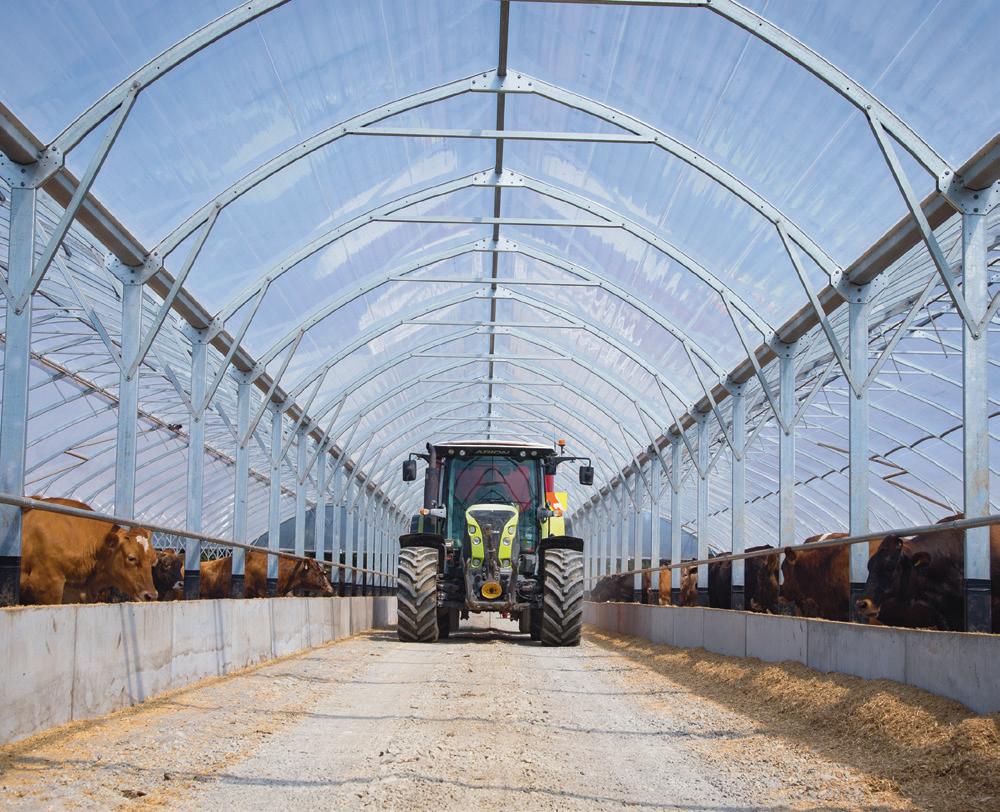


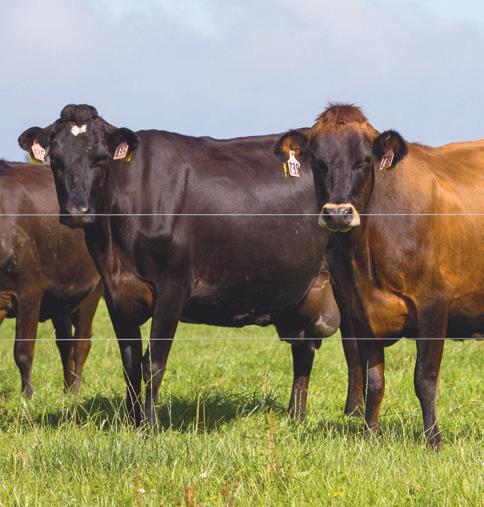
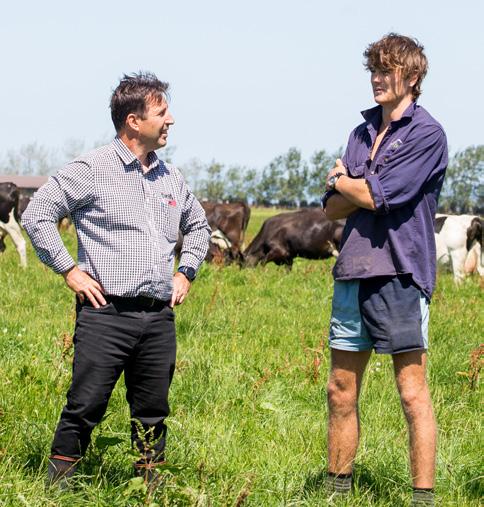
2 A new era of Wagyu excellence
8 The unsung story of local A&P Shows
14 A tough farming year finishes on mixed outcomes
18 Methven Store—providing choice for locals for 21 years
27 New role chance to reconnect with farmers
32 Ruralco board adds new directors for enhanced expertise
41 Rural advocacy is a team sport
55 Tyrewise kicks waste problem for good
21 Growing a successful maize crop in Mid Canterbury
25 Setting up for cereal success
28 Onslow’s absence not yet filled
35 Introducing ‘The Beast’
47 New digital tool helps dairy farmers maximise return on feed
49 Options to consider when preparing for winter
50 Extending the value of ryegrass seed crops
51 Grower rethink’s role of ryegrass in crop rotation
57 Demystifying water storage: navigating a freshwater landscape
59 Managing to maximise ewe conception rates
61 Christchurch men’s prison piggery fosters rehabilitation & sustainable farming

Having teamed up with Southern Stations Wagyu, Michael Schat has moved away from the dairy industry to pursue new opportunities as partowner and operator of the company’s first Canterbury-based state-of-theart wagyu composting finishing barn at Aylesbury.
WORDS AND IMAGES BY
ANNIE STUDHOLME& SUPPLIED.
Last month marked a massive milestone for Southern Stations Wagyu (SSW) as the first prime, grain-fed wagyus left the company’s Aylesbury finishing barn after spending a minimum of 100 days indoors, their sought-after meat bound for lucrative markets around the globe. It’s the culmination of many years of work and millions of dollars invested across the whole supply chain, from the dairy farmers who use SSW wagyu genetics across their non-replacement cows to the calf rearers, graziers, and now finishing. “It was very nerve-racking till that point,” says Michael Schat. “Getting some of the animals doing over 3kg/lw/day was a real relief as it’s a very long time from calf to processing, and a lot of money has been spent on the animal to that point. The grading was where we expected it to be, and weights were heavier than expected.” It was particularly significant for him, as many were animals he had raised as calves. “It was quite rewarding to see them go full circle.”
Having grown up on a dairy farm, Michael fell into the dairy industry. “I left school and went dairying because it put a roof over my head and provided a stable income, but I never really enjoyed it.”
Craving different experiences, Michael took time out, spending three years on and off working on sheep and cropping farms in Western Australia. At 19, his eyes were opened when he had the opportunity to work on a feedlot for a family regarded as one of the leaders in the grainfeeding game near Rockhampton, Queensland, an area essentially considered Australia’s answer to Texas. “They taught me a lot about feedlotting,” says Michael. “I was fortunate to be taught from the ground up, and it was a lifetime’s worth of knowledge. Being brought up on a dairy farm,

I knew how the animals worked. It was like giving them dessert every day. They like it, and they’re happy. You’re not asking them to do anything. I found it quite rewarding.”
On returning to New Zealand in 2008, Michael managed and share-milked his father’s dairy farm at Te Pirita for 10 years. After selling the farm in 2017, Michael stayed on as a contract milker. While there, he had his first dealings with SSW, rearing just 180 calves.
An Australasian subsidiary of farm finance company, StockCo, SSW was set up in 2017 to bring together the best farms and farming practices in New Zealand to produce some of the world’s finest Wagyu beef while at the same time transforming what would have been a waste product into a high quality beef product.
Worldwide, there are four recognised breeds of Wagyu. All Wagyu cattle derive from crossbreeding in the early 20th century of native Japanese cattle with imported stock, mainly from Europe. Red Wagyu (made up of Japanese black and brown) are the predominant breed, strongly influenced by Swiss Simmental and Korean Hanwoo breeds.

BELOW: Michael says getting the feeding right was crucial to the operation’s overall success. Everything was done with military precision to minimise wastage and improve overall efficiencies
Though not genetically related to Black Wagyu, they’ve been bred for the same marbling criteria in Japan. Red Wagyu’s fat was described as more like olive oil, while Black Wagyu’s fat had a buttery nature. Both are high in good oleic acid and low in cholesterol.
SSW provided genetic solutions to offer profitable dairy beef contracts to NZ dairy producers and farmers from its already established Australianbased wagyu bulls to artificially inseminate suitable dairy or beef cows or heifers, producing offspring that would go as premium-grade wagyu beef. The DNA-verified weaned calves were then sold through SSW to approved finishers participating in the programme before being repurchased at a premium price. SSW closely monitored every part of the process to ensure that best practices were followed.
Michael started small. Initially doing them on the farm before he and his wife, Leigh, purchased an 8ha lifestyle block nearby, building a customdesigned 340-head eco-tunnel house calf rearing shed, complete with an ingenious feeding system that allows him to rear large numbers almost single-handedly.
Back then, Michael was paid $700/110kg calf for autumn and $630 for spring-born calves. The dairy farmers supplying the calves, which were at least four days old, were paid around $300 and $200, respectively. Knowing these calves were sold at a fixed price, gave them the confidence to buy the meal and milk powder.
Ready for a change, Michael and Leigh took the plunge and gave up contract milking to focus entirely on rearing SSW wagyu-cross calves. He soon stopped doing the bull beef, Belgian
Blues and Friesian calves. Though the margins were similar, Michael says there was no ability to cashflow them. With the SSW, he could use their finance company to pay the $180/calf to the dairy farmers at pick up for a small finance fee when sold, effectively eliminating that considerable outlay of capital. Milk powder costs alone were upwards of $300,000, but with deferred payment it allowed him to do it effectively without the burden of any upfront costs.
Further investment followed. He built a second shed which allowed them to have 1,000 head undercover at any one time and ploughed money into machinery, including a fertiliser hopper converted into a grain silo and dispenser, a JCB loader spreader for straw bales, a gas califont for heating the milk, and a large-scale milk mixing unit. “We pretty quickly realised we could make more out of the calves. Now, the race was on to grow capacity. Because we had forward contracts with SSW, the banks were happy for us to do that. In three years, we’d gone from rearing 180 calves to 2,000. Suddenly, I was rearing almost a quarter of all of SSW’s calves in the country.”
Michael collected SSW wagyu-cross calves from dairy farmers across Canterbury. Once home, they were put in pens of 50, remaining in that mob until they were sent off to graziers at an average of 110kg. Most spent at least four weeks in the shed before being run out in small, sheltered paddocks. They were weaned at about seven weeks or 70kg but continued to have access to hay, balage and meal.
Though wagyu calves received a bad rap for being hard to work, Michael says not all wagyu’s were created equal, just as not all dairy cows are the same. SSW wagyu were a completely different genetic package. “SSW’s scrutiny of DNA proven calves allows the tracing of their weight gains and traits which gives them a real advantage over the other breeds. I find the SSW wagyus, bigger framed animals. I’d compare them more to Friesian bulls. They’re decent-sized animals that grow fast.” He says the key was getting a high starch diet balanced with protein and fibre into young calves to help lay down the fat that is the essence of wagyu beef. “We try to get starch into them young and as much as they can eat. It’s reasonably expensive at the moment, but we can see those returns late when those animals grow out that
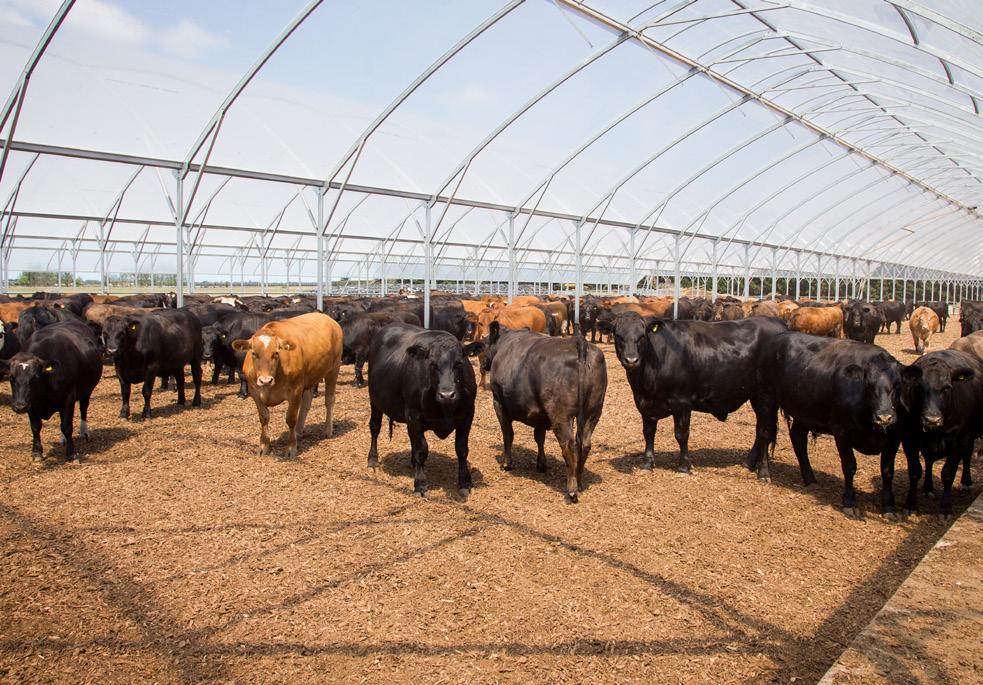
they have laid that fat down from a young age. That unlocks their ability to really marble. They put on excellent weight gains by having them ad-lib at high grain concentrations.”
Michael’s success and diverse skillset did not go unnoticed. In 2022, SSW approached him about partnering with them to set up a finishing barn. While the calf rearing had the potential to be lucrative, it was hard physical work, and he was ready to pass the torch over to someone else. SSW’s offer presented tremendous opportunities. He was up for a new challenge and drawing on his previous experience, Michael knew he could do it. It was something that he’d thought about often since his time in Queensland.
“It wasn’t easy to make it happen. I’m glad I did it with SSW and not by myself like I had originally planned. I’m 38, I’m not 28 anymore. I have put in the hard yards and worked my guts out. I have a young family (sons Charlie, 10, and Liam, 8), and I’m trying to do a bit less now. Not having to get up in the early hours of the morning is a real life-changer. While it’s not for everyone, I enjoy that the animals are always happy and out of the weather. I’m also finding it a more attractive career for staff.”
Michael only raised 1,650 calves this season; his priorities were getting the farm and finishing-barn

ABOVE: “They are warmer on a cold day, but not too warm on a hot day. They really only have to eat and sleep. They think life is pretty great,” says Michael BELOW: The barn had been designed with temperature-controlled venting, a centre feeding lane and external feeding lanes to ensure the cattle are content in all conditions
fully operational. Ultimately, he and the family would move to the Aylesbury farm to focus on the grazing and finishing operation.
Getting the whole operation off the ground hadn’t been without its challenges though. SSW and Michael jointly purchased the 206ha sheep and cropping farm last May. After a few hold-ups, building finally started on the 106m x 99m selfcomposting, eco-tunnel barn in September, with construction finished just before Christmas. “It’s been very stressful. We didn’t have anyone to copy, so we had to do a lot of research, come up with our ideas and bring it all together. There was no plan to build to. We’ve been up against it a little bit, but I think once people see what we’ve created here people will be happy,” says Michael. Environment Canterbury had very robust criteria that must be met. SSW had worked closely with ECan to ensure the barn meets all environmental standards. “The system is driven by very high environmental standards and outcomes, and we’ve spent a lot of money on environmental mitigations. That should give people confidence in what we are doing.”
The barn had been designed with temperaturecontrolled venting, a centre feeding lane and external feeding lanes to ensure the cattle are content in all conditions. The sides were open to the elements to create airflow. Though they were consented to 8m2 per animal (1,250 total), they were currently only running at 10m2 per animal (1,060 total).
“There is loads of room in there to move about if they want it, so they seem to love it. I believe the animals do much better in the more natural conditions. We use the sun to the best of our ability. They are warmer on a cold day, but not too
warm on a hot day. They really only have to eat and sleep. They think life is pretty great.”
The barn was designed with a low environmental footprint, explains Michael. The hard floor prevented possible nitrate leaching, while it was 100 per cent self-composting. A 5,000m3 layer of wood chips would be transformed into compost through animals’ nitrogen-rich urine and dung. There would be no leaching as the high temperatures in the compost would burn off any liquid. Weekly rotary hoeing ensured the surface was mineralised and clean, improved aeration, reduced temperature, and limited odour, with new wood chips added as required. Ultimately, the compost material would be spread over the farm in place of synthetic fertilisers.
Everything was carefully monitored, says Michael. “Winter will be the real test when it’s not as sunny. We will need to balance rotary hoeing to control temperature. There are a lot of fickle things that have to be scrutinised.”
Animals arrive at the barn at 20–24 months of age, at 550kg (approx.) live weight, and leave at 750kg live weight (720kg empty) on average four months later (a minimum of 100 days), depending on each animal. Animals were only weighed in and weighed out at the start and the finish otherwise they were left alone. They aimed to produce a 400kg carcass with a marble score of at least six or above. As well as getting the animals fat, the high starch diet helped replace the yellow fat (taint from pasture) with the bright-white fat favoured by the Wagyu and grain-fed market. Animals were then toll-processed by a premium export processing facility for Australian-based Endeavour Meats, which marketed it worldwide.
Michael says getting the feeding right was crucial to the operation’s overall success. Everything was done with military precision to minimise wastage and improve overall efficiencies. Their diet consisted of a mixture of crushed barley, maize silage, molasses and other specialised nutrients and minerals. Using scales on the mixing
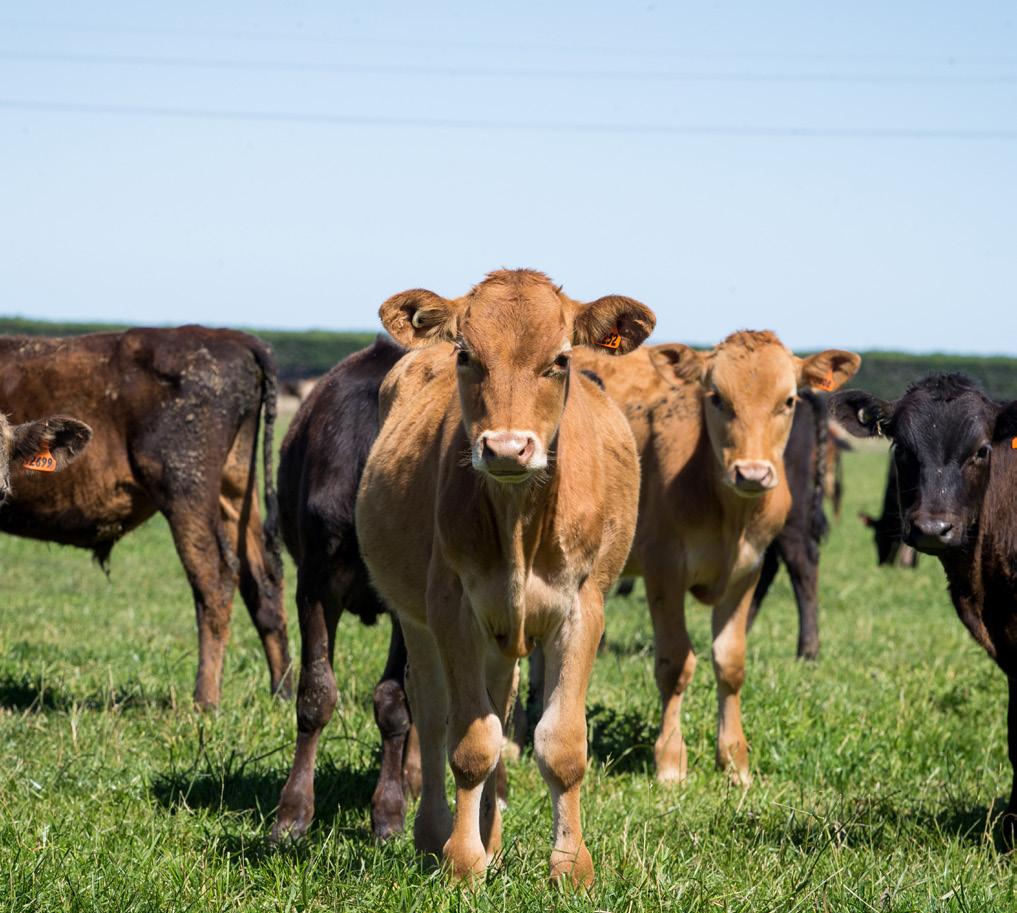
kilo. Loading, mixing, and feeding could be done in under half an hour with the animals fed once a day.
“We are constantly watching and seeing what they are eating and are making fine-tuned adjustments. Each mob gets its specific brew depending on its intake and the ingredients in their rotation. We try to keep things consistent, feeding at the same time each day. Maize silage is a vital part of the system. It makes up two-thirds of the diet at initially, dropping to 20 per cent by the end. There are five different rations in total. We try to do it perfectly to minimise any wastage.”
While buying in barley, they had grown 45ha of maize this season, using water from wells and
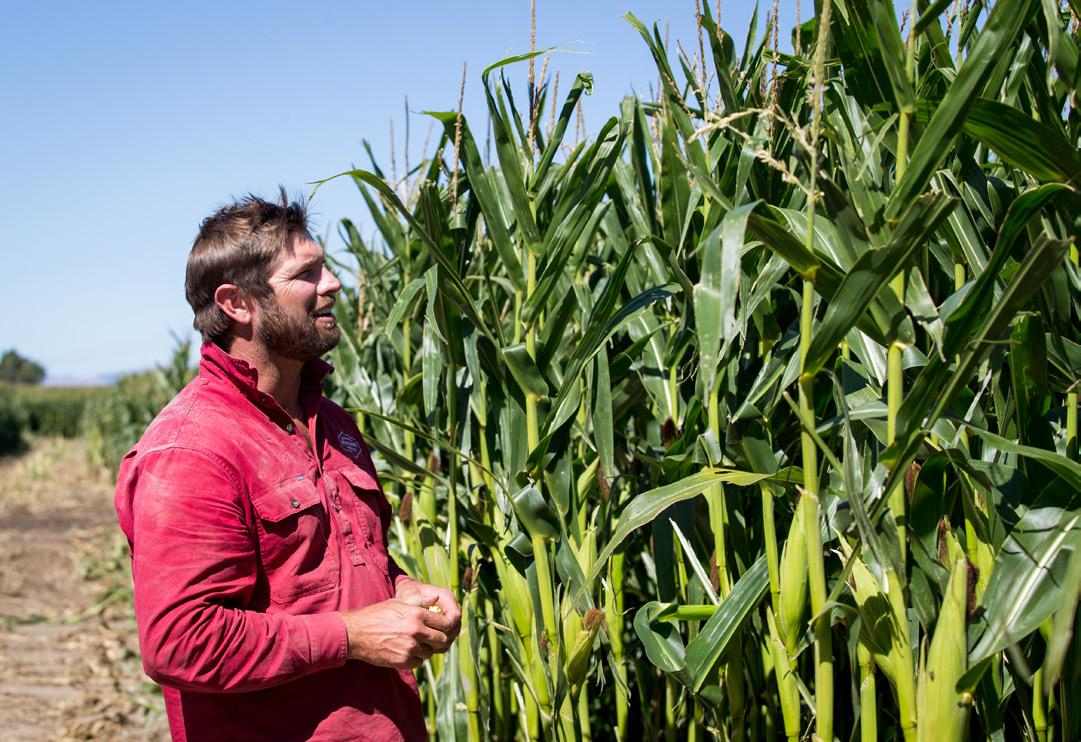
ABOVE: Though wagyu calves received a bad rap for being hard to work, Michael says not all wagyu’s were created equal
BELOW: Maize silage is a vital part of the system. It makes up two-thirds of the diet at initially, dropping to 20 per cent by the end
CPW. Growing their own maize allowed them to grow precisely what was required. It was cheaper that way and gave them more control over the product’s quality, cut cartage costs, and helped avoid market fluctuations. In the future, they would also be able to use the compost from the compositing barn to cut down on fertiliser costs, explains Michael.
As was to be expected, they’ve struck a few early teething problems, but overall, he says it was going better than ever anticipated at this point. He was excited about what the future holds. At this stage, they aimed to finish 3,000 SSW cross cattle annually, but in a world that’s crying out for rich, marbled meat that sits at the premium end of the market, Michael saw enormous opportunities for growth. It also could potentially solve some of the country’s bobby calf issues, remove issues surrounding winter grazing and reduce N numbers considerably. He believed New Zealand was wellplaced to take advantage.
“It’s really exciting, but it’s about getting everything right. Everyone along the whole supply chain needs to be doing a good job for it to work. Any poor-performing farmer equals lost potential. If possible, we will likely build another one (feed barn). Feed lotting is only in its infancy in New Zealand. Overseas, feed lotting is huge; New Zealand is just a drop in the ocean. The sky is the limit to a certain point, providing we can tick all the boxes.”



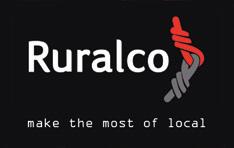



Long-held features on local calendars for showcasing the district’s agricultural strengths, reinforcing community connections in a fun-filled family environment, and celebrating all that it is to be a Kiwi, the Mayfield and Methven A&P shows will run on consecutive weekends this month.
WORDS BY ANNIE STUDHOLME, IMAGES BY ANNIE STUDHOLME AND BEN DOUBLEDAY PHOTOGRAPHYPart of New Zealand’s rich rural history, since the first Agricultural and Pastoral (A&P) show was held in the Bay of Islands in 1842, A&Ps were started to promote farming pursuits. The idea of these societies and shows came from Britain, where the first one was held in 1822.
In the beginning, farmers displayed their animals and crops to show excellence. By fostering friendly competition, the aim was to improve the quality of stock and produce and, therefore, the whole district.
As A&P shows grew in popularity, though, other competitions, attractions, and family entertainment were introduced, cementing them as an essential feature of community life for the district and the entire county. There are now 94 annual A&P shows across New Zealand; for many towns, it’s the biggest event of the year. No two shows are the same; they’re unique to every town. And that is certainly the case for Mayfield and Methven.
The Mayfield A&P Association will host its 98th show on Saturday, 9 March, and the Methven A&P’s 108th will be held the following weekend on Saturday, 16 March. In the face of dwindling interest, low entries and low attendance in other areas, these two shows continue to offer something for everyone, with lots to see and do.
The Mayfield A&P show’s story is one of progress. Following the footsteps of the Ashburton and Methven districts, the Mayfield A&P Association was formed in 1919 to look at the prospect of holding a show in Mayfield. Largely because of the boundless energy, initiative, and optimism of one man—Mr Donald Duff, who was elected inaugural president—the first show went ahead on 8 April 1920. Backed by a dedicated core committee (many of the families that are still involved to this day), it attracted 626 entries across the sheep, cattle, horse and pony, dogs, pigs, poultry, home industries and juvenile sections; even more impressive when you consider it was only open to residents from within the Mayfield District. What had been an enormous gamble had paid off. Crowds flocked through the gates, and all enjoyed the day. By the following year, entries had doubled and before long, the Mayfield show had cemented a reputation for being one of the best district shows in the province. It not only improved the stock quality in the district but played an essential role in increasing the co-operation and understanding between urban and rural communities.
A favourite amongst exhibitors and the community, the committee was enterprising,

constantly adding new events and attractions to pull the crowds, a feature that has become a hallmark of the show over the past 98 years.
In the early days, this included the likes of driving and horse-harnessing competitions for ladies, car driving for all, tilting the ring for motorcycles, solo and side-chair, sheaf throwing, chain stepping, and weight judging. While the sections remained the same, the committee introduced a new Schools’ Agricultural Clubs section in the 1930s. A rabbit section also briefly appeared but was scrapped several years later.
After being hit hard during the war years, the Mayfield A&P Show was resurrected in 1946 after a five-year absence, with solid entries and attendance reaching well over 3,000. It was then hit with poor weather and the abandonment of the show in 1948 due to the polio epidemic. But despite some tough times, inspired by those that had come before them, the committee rallied, determined to put on a great spectacle for exhibitors and the public alike.
That sense of legacy is not lost on this year’s Mayfield A&P president, Ben Morrow. Ben’s family have been involved in the association since the start. Both his parents have been long-time committee members and served at the helm. His
father, Mark Morrow, was president in 1993, and his mother, Nicky, took on the role in 2007. Mark was integral in getting the show’s world-famous pig racing off the ground. He was responsible for the training back then, whereas that task has fallen on Ben’s brothers-in-law this year. A staunch supporter of the show, putting in entries every year, Nicky has been made patron this year. Having grown up surrounded by such a strong involvement in the show, it surprised no one that Ben joined the committee about 10 years ago. While stepping up as president had come sooner than Ben anticipated, he’s proud to continue such a long family tradition.
Although the show has changed dramatically in 98 years, he says its core functions remain unchanged. It is still an important way to showcase the district, unite the entire community, and bridge the gap between urban and rural communities.
“It’s a great opportunity to get everyone in the community together, allowing people to catch up with neighbours, friends, and family. When you are busy farming, you often don’t see your
neighbours, and especially in tough times it is so important to talk to others and realise everyone else is facing similar challenges. Along those lines, this years’ theme is rural mental health, and we are lucky to have celebrity presenter Matt Chisholm from the Rural Support Trust coming to the show.”
Mayfield epitomises your small, rural show. While it’s small enough that it has a great, safe, family-friendly environment, it boasts some unique attractions such as the pig racing and the tractor pull, as well all the regular favourites like horses, cattle and sheep, shearing, arts and crafts, scavenger hunt, the pet tent, trade stalls, produce, food, and live entertainment.
“It’s a busy show with many little things going on. It punches well above its weight,” says Ben. Like their forebears before them, the committee remains progressive. “We are constantly thinking about having a point of difference to entice more people through the gate. That’s what was behind the pig racing initially, but they proved such a crowd-pleaser we have never got rid of them.”
Since 2018, Mayfield has also run a successful tractor pull event, attracting more than 50 tractors across several sections. It is now part of a nationwide circuit. The following year, they also added the tug-o-war competition with people against a Clydesdale team, which had also proved popular.
New for this year is a digger competition where they’re asking local contractors to put their skills and tricks to the test. Ben says in time they may consider making it part of a circuit if there’s sufficient interest. “This year is very much a test, but we’re hopeful.”
“We have to keep thinking outside the box. We are worried that if we don’t have something new, we’d just become another statistic and just wind up. And none of us want that to happen. As a district, we are not that big. We are indebted to all our sponsors; without them, we couldn’t run the show. So many people put in a lot of work, from the horse convenor to the Lions’ on the BBQ. The whole committee works tirelessly to


make it a success, but we need the community to support it.”
Two years from its centennial show, Ben says the focus is on keeping it cash-positive so it can invest back into the A&P grounds and ensure this great event can continue for years. “We need to invest in infrastructure to help safeguard it for the future. Last year we were lucky, we had a perfect day and made a small profit. But it’s very weather-dependent. Without the gate takings, we struggle to make a profit on a rain-affected day. A big shed would help.”
Ben encourages everyone, young and old, to get behind this wonderful community-focused event and come out on 9 March to enjoy everything it offers.
Seven days after the Mayfield A&P show, it’s the Methven district’s turn to shine, and though there are many similarities, the Methven A&P Show (16 March) is unique in its own right. This year marks its 108th show and along with the famous Methven Ute Muster (started in 2021), the Art Precinct, which showcases local artists, is set to return this year after
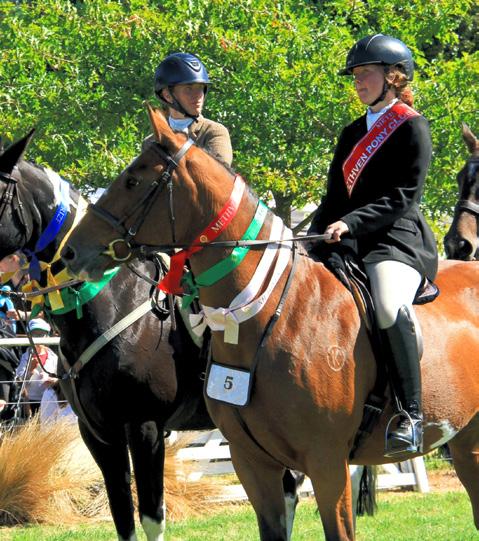
BELOW LEFT: Locals and rural people from further afield take part in the famous Ute Muster and horse shows at the Methven A&P Show
BELOW RIGHT: The Methven A&P Show boasts a full programme of more traditional events including sheep, wool, wood chopping, shearing, equestrian, dancing, dog trials, poultry, dairy goats and home industries
making its first appearance in 2023. It also boasts a full programme of events across the more traditional sheep, wool, wood chopping, shearing, equestrian, dancing, dog trials, poultry, dairy goats, and home industries sections. There is also Spud In A Bucket and colouring in competitions for the children, as well as pony rides, face painting, balloon twisting, and the ever-popular animal shed.
The Methven A&P Association was founded in 1911 to further the agricultural interests of the district, educate farmers by promoting the discovery of new varieties of grain and other edible plants, encourage the best mode of cultivation, and improve livestock. While some saw the move as premature, thinking it would be unable to compete or compare with older, more established associations, an enthused group forged ahead, and the first Methven show was held at the Methven Domain on 11 April 1912, with Mr Alexander Orr as president.
The show then moved to the Mt Harding Racecourse until moving to the current showgrounds on Barkers Road after purchasing the land in 1920 at £65 per acre. Millichamps drew up a plan for tree planting and fencing. Progress on the new grounds was slow. Just before the 1928 show, Mr Orr died, leaving a bequest of £500 to erect a building on the showgrounds, meaning a pavilion could be built. Designs were done, and by January 1929, the Shearer Brothers’ tender of £994 was accepted. To their credit, they completed the iron and concrete building in months. The first show on the new grounds was held on 27 March 1929.
Competitions on show day have included sheaf tossing, chain stepping, motor car driving competition (started in 1913, deleted in the 1920s), a troop horse class in 1917, and a soldiers’ work collection (cane and leather work) and military section (deleted in 1938), the ploughman’s lunch in the cooking section, wool classes, shearing competitions, wood chopping, spinning and knitting displays, the lamb cuts, and chiller beef competition. The sheep, cattle, and horse sections have remained a mainstay of the show. They were there at the beginning and still attract solid entries today.
Aside from the annual show, in line with its original objectives, Methven A&P has also run the flock ewe competition, the A&P draught horse committee to select stallions for use around the district, the ram fairs, the stacking competition, ploughing matches, lucerne plot competitions, winter feed competitions, dairy heifer competitions, wheat competitions, and gift lamb competitions. In later years, it started a caravan park and camping ground onsite, while the grounds have also been used for football and rugby training.
Early on, the Methven A&P was also a voice on national issues. In 1912, it sent a letter to the government of the day in support of the “Keep Our Ports Open” campaign. Four years later, they wrote again to protest on how New Zealand meat was sold on the London market. Again, in the 1930s, the committee wrote to the Prime Minister expressing their concerns over the use of imported whale oil (used as a gearbox lubricant) and its damage to the tallow industry. Local issues were also aired at A&P committee meetings.
Though the delivery is slightly different, that issue-centric focus has morphed into having a theme for each year’s show in recent years. Following last year’s successful theme of “Rural Wellbeing”, which included free blood pressure and hearing checks on show day, this year’s theme is “Getting Involved in Your Community”, zeroing in on all the community groups and activities Methven offers.
It’s one area dear to this year’s Methven A&P president, Irishman Trevor Monson. “You just don’t realise what’s there until you start looking.
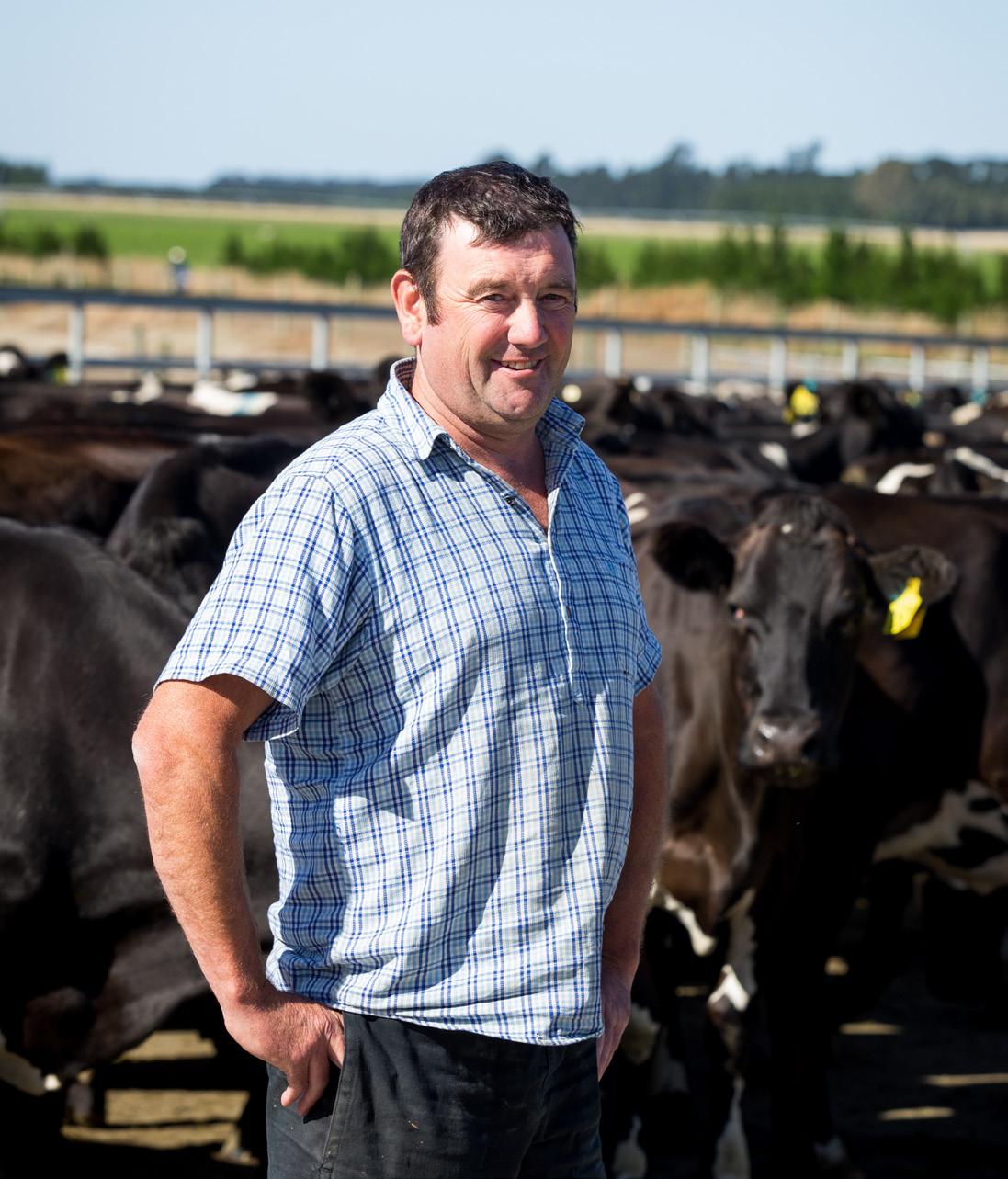
He joined the committee 13 years ago to meet people and get more community involvement. “It’s been fantastic. I love the people that I mix with. We all support each other. There is no pressure. It’s family first, work, then the committee. A lot of effort goes into pulling off the show, but we have a lot of fun along the way.”
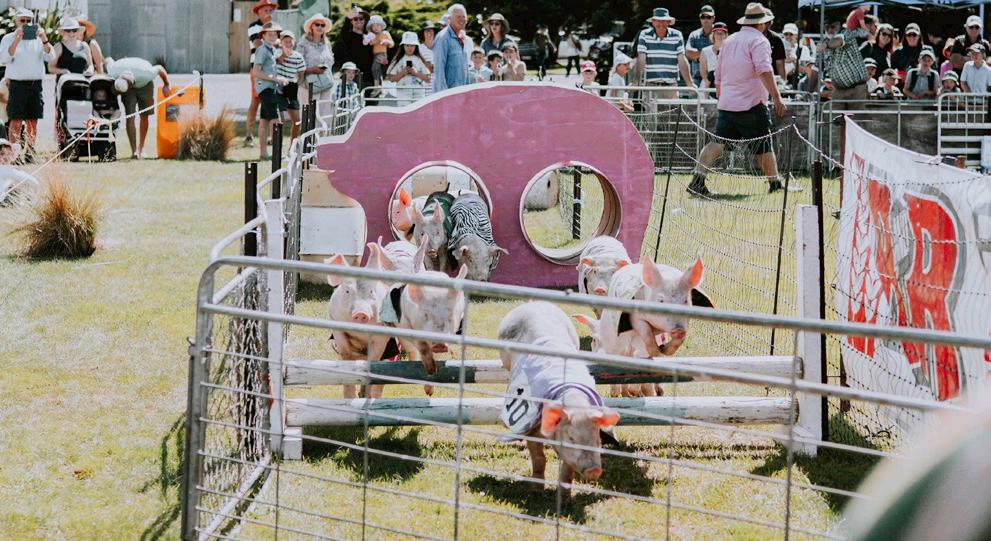
But even with the colossal support it receives from local businesses and exhibitors to volunteers’ dedication, commitment, and enthusiasm, he admits the show would be nothing without the public. While it has its loyal supporters who turn out in their droves yearon-year to catch up with neighbours, friends and family, being only an hour from Christchurch and Geraldine, it’s the perfect distance for those from further afield who are keen for a great day out.
“People just love coming back to the show for an action-packed day,” says Trevor. “It’s a nice freeflowing show with something in every corner of the showgrounds. There is always something going on—never a dull moment. When you think about it, the list of events and attractions is never-ending. There is something for everyone.”
Over the past century, A&P shows have become a significant feature of the agricultural landscape. Started originally as a way to celebrate excellence and improve the quality of the produce and livestock, A&P shows have become much more. They unite communities and entertain all people and interests, not just farming enthusiasts.





As the farming season draws towards a close, the ups and downs of a particularly tumultuous year have finally started to make themselves clearer as crops are sold, herds start to be dried off, and the last of the season’s lambs are sold.
WORDS BY RICHARD RENNIE, IMAGES BY ANNIE STUDHOLME AND LARRY PROSOR.Depending on what side of the fence your farm business is in, the outcomes for farm profit and loss are likely to be quite varied, coming after a few years where most sectors have almost uniformly enjoyed buoyant returns.
Dairy farmers kicked off the 2023–24 season with prospects of an extremely tough year
ahead, with prices well below break even, cost increases well in double digits and the grim prospect of being unable to clear the farm overdraft before year’s end.
But a shift in global dairy dynamics proved just how volatile the sector can be. No sooner had processors announced drastic reductions in payout to a midpoint of $7.00/kg of milk solids, well below a realistic breakeven for most, than global milk prices took a turn for the better.
Within only a few weeks of the announcement Global Dairy Trade prices started to march north, with four consecutive lifts putting values well back where they were prior to the slide.
With prospects of dairy payouts now sitting well over $7/kg of milk solids, and even having an upper level with an $8 in it, dairy farmers can justifiably finish this season with a sigh of relief that revenue is at least going some way to offset
the dizzying surge in interest and farm costs they have faced.
China’s reticence to buy whole milk powder appears to have eased, while there is little prospect growth in global milk supply through the second half of this year to knock prices back again.
Over the other side of the fence, sheep farmers may well be gritting their teeth and crossing fingers things pick up for the new farming season, with 2023-24 proving to be one to forget. As lambs reached weight late last year and were ready to be quit, prices started to drop quicker than forecast, with one processor lowering its prices for lamb through to January by a further $1.10/kg.
China’s slowdown has continued to impact harder upon sheep meat than dairy, while industry heads have warned that any turn
around may not be seen until well into the second half of this year.
On top of China’s economic slowdown has been the supply side impact of Australia’s big surge in lamb supply. Coming after four years of reliable rainfall and good growth, Australia has set itself up to knock New Zealand off its spot as the world’s largest exporter of sheep meat as restocked flocks have been reduced in the face of predicted drought this summer.
Those reductions in numbers have also included significant levels of capital stock sold as mutton. By early this year the Australians had exported 85,000t more sheep meat than for 2022.
The hit that Australian farmers have taken to claim that title has been significant however. By late spring last year, they were receiving prices almost A$3.50/kg below their five-year average, and a full A$2/kg lower than what New Zealand farmers have been receiving. This gives some hope to farmers here that such values will soon be revealed for how unsustainable they are and put the brakes on future surges in supply.
Meantime the drought prospects that prompted so many farmers to quit stock did not materialise as early as expected, leaving depleted flocks and likely to also stem the flood of cheaper Australian sheep meat that has contributed in part to farmers’ woes here.
While returns are likely to remain down for the first half of this year, the drop is not as great as what Australian farmers have had and highlights how well New Zealand processors have done to retain value in New Zealand lamb as a premium product.
Adding to concerns however is the massive stockpile of sheep meat already held in China, with estimates that the 1 million tonnes are almost double what is usually held, further fuelling prospects any turnaround is unlikely until the second half of this year as that stockpile gets reduced.
Beef
Beef farmers have been spared quite the pummelling sheep farmers have had in the past year, and the impact of drought in the United

States is likely to help cushion any future risk of value slide.
United States farmers have been liquidating herds in response to drought challenge and are expected to continue for the remainder of this year. A third of the United States is feeling the pinch from drought with the national herd estimated to be 3% lower by January compared to the same time 2022, and supplies of beef are estimated to fall to levels last seen in 2019.
The sector has enjoyed a steady gain in volume sales of 20% in the last five years, accompanied by solid prices as global demand for beef continues to grow with emerging middle classes wealth gains through China and south-east Asia.
The United States’ loss of herd helps counter continuing strong competition from the likes of Brazil and Australia, and New Zealand’s tendency to provide the low-fat ground beef addition to cheaper takeaway type products is a good place to be when consumers are more conscious than ever about the cost of protein.
The biggest challenge for beef farmers over the coming year will include working to adopt a lower carbon profile, in the face of growing efforts by Australia in particular to deliver
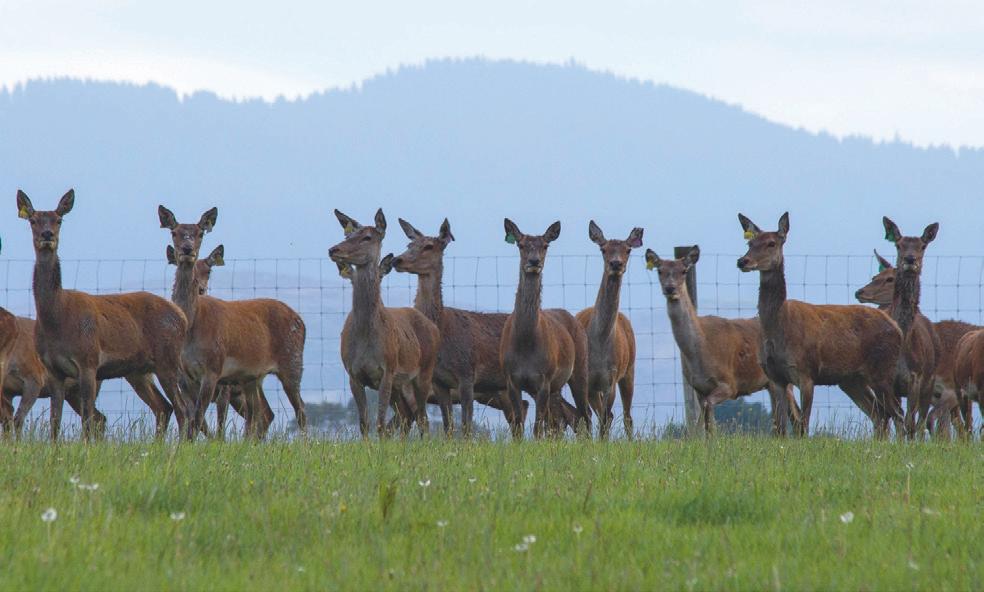
carbon neutral beef by 2030 and the focus of significant industry led initiatives through their CN30 campaign, many which are still to gain momentum here.
Venison
Venison farmers had a tough run through Covid, with the global pandemic shutting down many of the high value hotel and restaurant outlets that featured New Zealand product. Previously healthy prices crashed below $7/kg as exporters struggled to move product, often doubly limited by the loss of timely chilled shipping routes.
But with a strong industry focus on diversifying markets and product, the sector is now looking significantly more robust with returns once again up over the $10/kg mark in response to strong demand.
Farmers can finish the 2023-24 season after a tough spring that had stock finished later than usual, forcing air freighting to meet delivery deadlines, and keep promised orders filled.
Processors have been left with the luxury of turning away some enquiry while markets are responding well to the variety of new branded venison products that have helped reduce reliance upon only top end cuts.
Meantime velvet has also been given a valuable boost in the past year that sets it up well for the new season’s trade. The approval late last year by South Korea’s food safety authority for New Zealand velvet to carry functional food claims is the culmination of several years’ worth of work and co-operation between New Zealand researchers and South Korean pharmacy and regulatory agencies.
The claims for prostate function and antifatigue add a valuable unique selling point to New Zealand sourced velvet in as a functional foods ingredient that fits well in a market very familiar with traditional deer antlers’ value as a tonic and healing compound.
The functional food supplement market is worth about $6 billion a year, and has the New Zealand industry fulfilling its aim to further diversify and add value for farmers here.
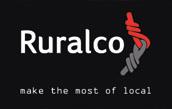





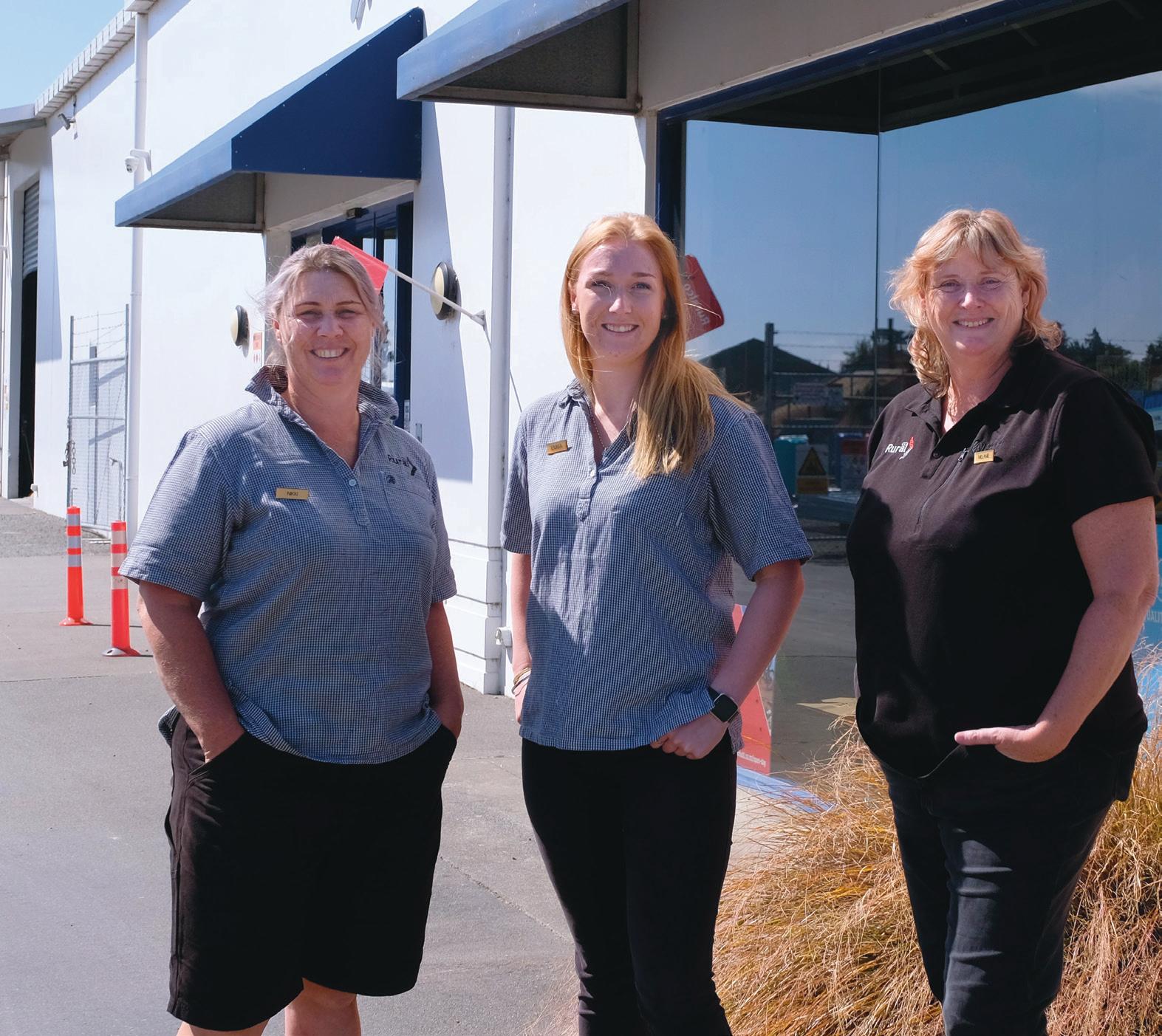
Ruralco’s Methven store came to fruition thanks to the confidence being experienced by the agricultural sector in the early 2000s.
WORDS BY ANITA BODY, IMAGES BY INDIANA ROBERTSIt was a time of growth and development for the co-operative which had just launched its call centre, the retail arm of the business had celebrated its 25th birthday, field representatives were introduced, and Saturday
trading had commenced at the Ashburton store. By 2002, the co-op had secured its 2,500th Shareholder and the following year saw the opening of the Methven store. Former ATS Board Chairman and Director, Phil McKendry says the Board could see there was a lot of opportunity for growth in the local community, largely due to irrigation development taking place, especially with the prospect of BCI (Barhill Chertsey Irrigation) becoming a reality.
“We had a lot of confidence. We had already opened the Rakaia store, it was operating very successfully from day one, and that also gave us the confidence to do the job in Methven too.”
He recalls there was a lot of amalgamation and consolidation going on within the farm supplies sector and the Methven store added a further layer of competition in the district. “We managed to secure a great site on the main street. It was a council owned empty section which was being used by the (Mt Hutt) ski field
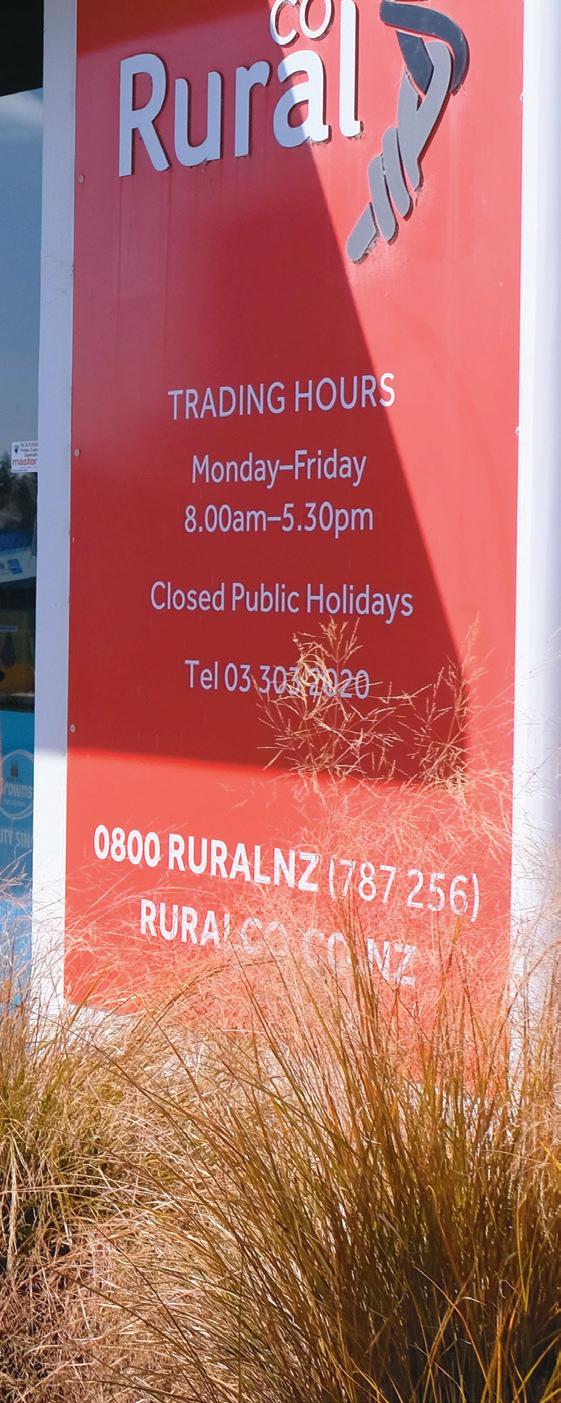
for parking. When we learned it was available, we were pretty quick to put down a deposit.” It has proved to be a successful decision, allowing a purpose built premises to be developed with ample parking, great storage for large items, and the potential for growth if ever needed.
Phil says it’s been important for the area. “As a local farmer there’s a lot of choice and competition. Ruralco has to have a market leading offering to ensure it stays competitive in that environment and sustains farmer-owned competition in the farm supplies sector.”
Part of the store’s ongoing success has been its staff. He says having a team who are well known in the community and provide great service is important. “The store has always had good leadership and good staff and service. It’s easy to shop there.”
Since its opening in June 2003, the store has had three managers—Jill Houston, Hannah Bramley and most recently, Mel Sowden who has been with Ruralco for 13 years, and manager of the store for 10. She lives at Surrey Hills Station and has spent 23 years on the sheep and beef property with her family. She lives and breathes farming every day and it’s that connection to the land and the community which is so important to the Methven store team.
“The store has always had good leadership and good staff and service. It’s easy to shop there.”
Both Nikki Taylor and Emma Hussey also share those connections. Nikki has had years of farming experience, especially around dairy farming and calf rearing, while Emma has a sheep and beef background, both here in New Zealand and in Australia. With a Bachelor in Agriculture and a Graduate Certificate in Applied Science, Emma also recently won a scholarship to attend the GenAngus Future Leaders Programme—an intensive threeday event led by experts, providing valuable industry insights.
In addition to the retail staff, members of Ruralco’s On-Farm team can often be found
in store, especially Jelle Hendriksen, who has extensive dairy knowledge, and local agronomy expert, Ricky Brown. Mel says it’s an added bonus to have them regularly available to share their knowledge and connect with locals. Those connections are important to the team. “We love our customers. They are like family to us; we learn what’s going on their lives and we are there to help where we can,” says Mel. While there’s real benefit to being convenient for locals, meaning they can shop closer to home, Mel says it’s also about the support Ruralco shows the locals. “You’ll find the team supporting local events like the Methven A&P Show or the local scarecrow trail. We even hosted Ruralco’s first Ladies Night back in 2016 with TV personality and cook, Jax Hamilton,” she says.
While having a great product range is obviously vital to the store’s continued success, Mel says the gift and homeware section is a real point of difference. “It really is one-stop shopping, with something for everyone.”

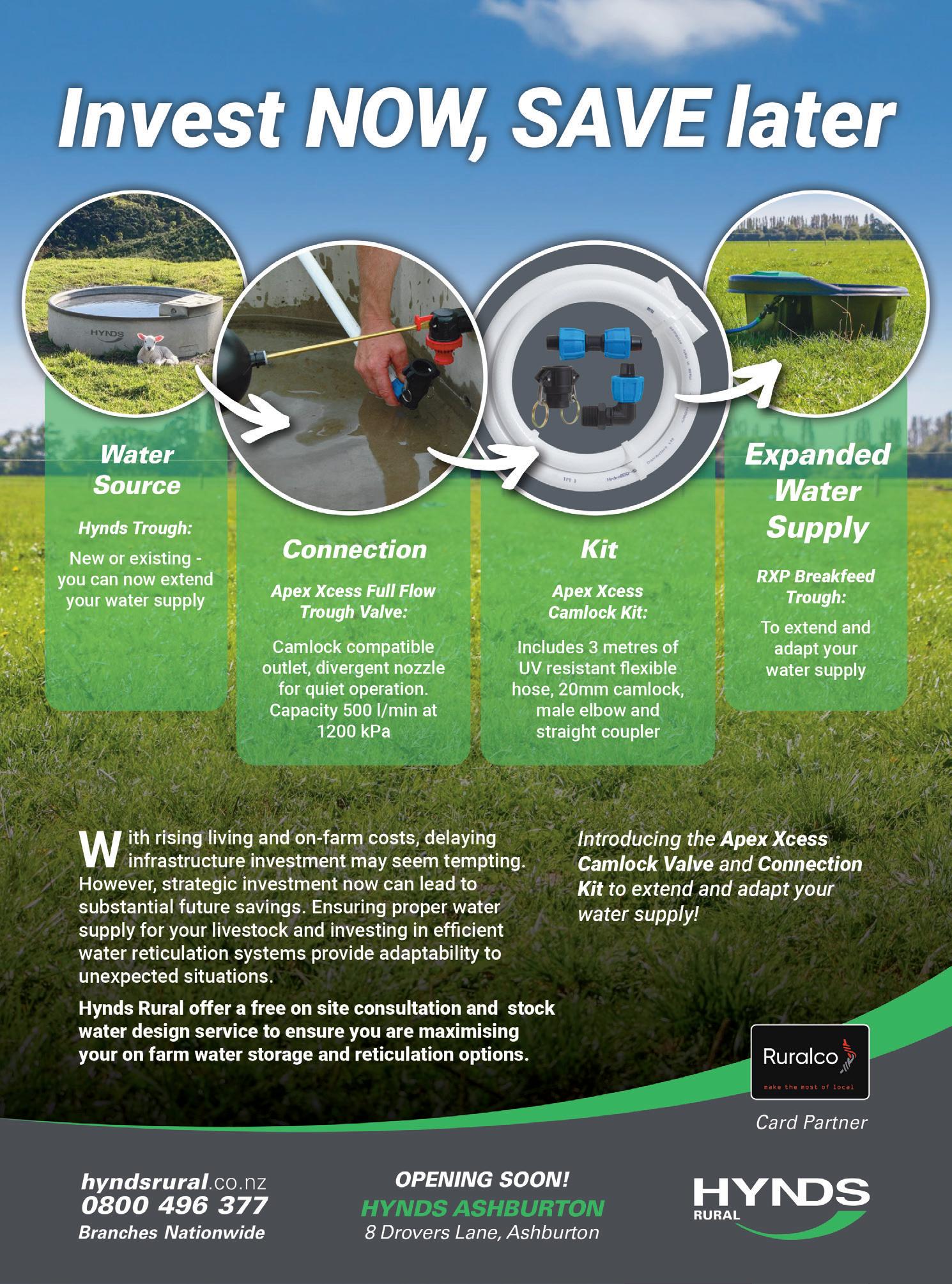

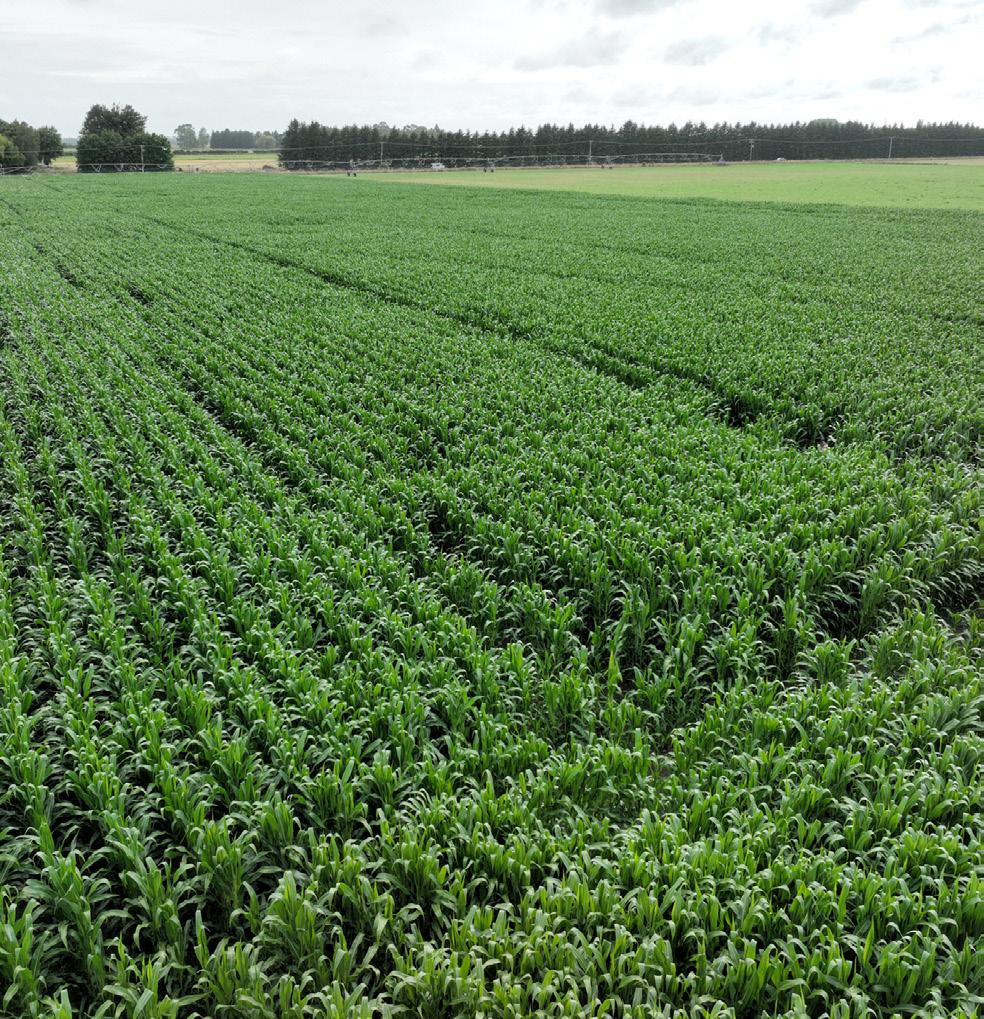
Jason and Clare Nish have successfully grown maize in Mid Canterbury over the past ten years.
In the spring edition of Real Farmer, we covered why Jason and Clare Nish use maize on their 185ha 630 cow dairy farm. This article explores the challenges of growing maize and outlines the strategies implemented in partnership with Ruralco and Pioneer to grow a successful maize crop.
This spring, Jason planted 10.5 hectares of maize into a sprayed-out paddock of Italian ryegrass and cultivated it to create a nice fire seed bed. A precision planter was used to plant the crop on the 25th of October at a sowing rate of 115,000 plants per hectare. “Over the years, I’ve tried and tested several varieties, but this year, I chose to plant P8333,” said Jason. He explained that he always tries to keep up with the latest advancements in genetics to ensure he uses the best hybrid. During the establishment phase, the crop faced a weed challenge. However,
Melinda Driscoll, Ruralco’s Senior Dairy Specialist, assisted by making a spray recommendation that effectively controlled both broadleaf and grass weeds. Melinda
emphasises the importance of conducting regular crop checks during the establishment phase to promptly identify and address potential challenges.
Jason followed a fertilisation plan tailored to meet the crop’s specific needs. The fertiliser was divided into three separate applications, with the first applied as a base fertiliser at the planting time. The remaining two nitrogen applications were split and applied after the establishment of the crop, ensuring optimal growth and development.
Rachel Bell, Pioneer’s Canterbury Area Manager, inspected the crop with Jason as it was tasselling earlier in the year. Rachel commented, “Weather conditions have been ideal with plenty of rain. Despite the early weed pressure, the crop is looking great and should be on track to yielding between 22–25 tDM/ha”. Based on how the crop is moving through its growth stages, it should be ready for harvest around early to mid-April.
In the last couple of years, new shortermaturity hybrids have been introduced in the South Island. This new trend is proving to be highly beneficial for farmers as these crops are more consistent and ready for harvest earlier, allowing grass planting in the Autumn.
To learn more about the best practices for growing maize, contact your local Ruralco or Pioneer representative, who will provide all the necessary information.
THIS PROMOTIONAL FEATURE WAS PROVIDED BY PIONEER
IMAGES: This spring, Jason Nish planted 10.5 hectares of maize into a sprayed-out paddock of Italian ryegrass
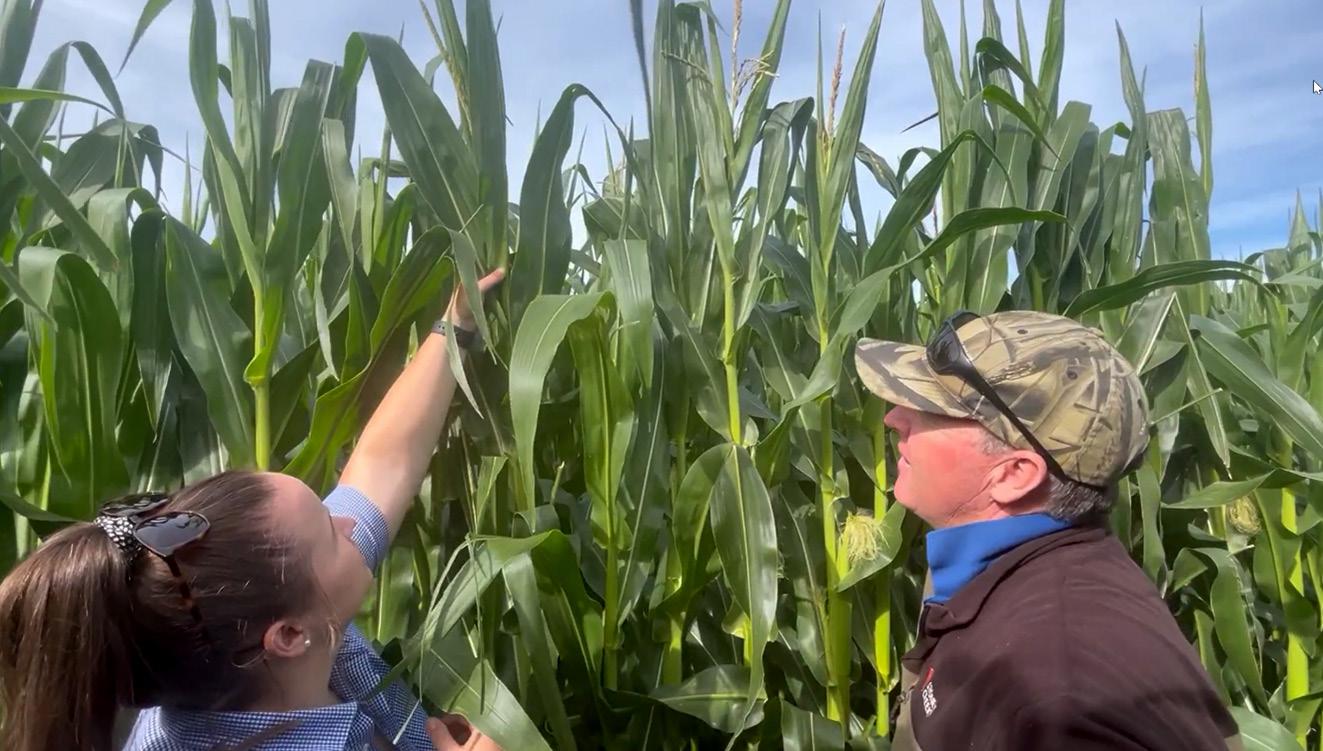




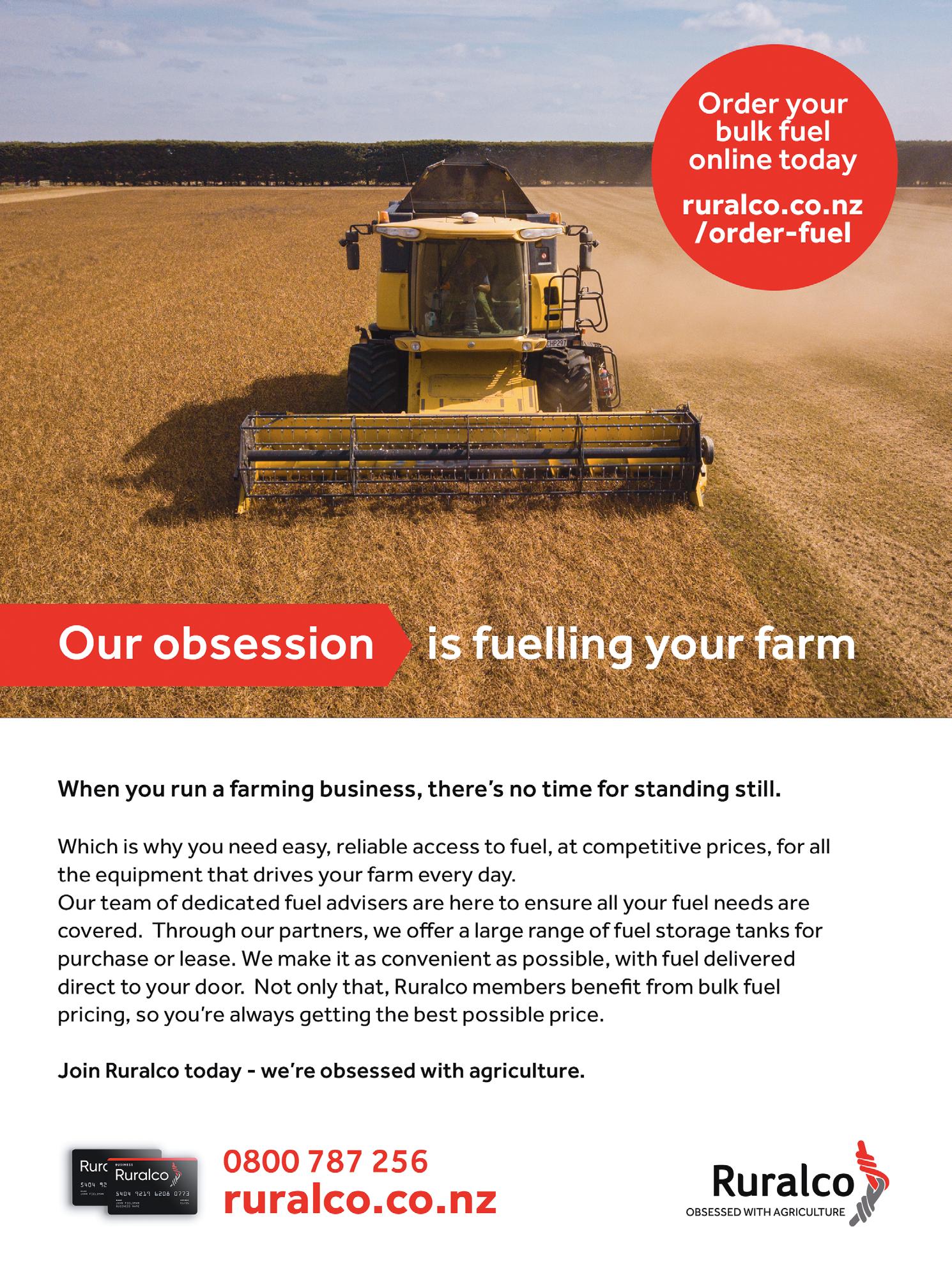


Look back and plan ahead to get the most from your autumn sown cereal crops.
To get crops off to a good start, it is best to maintain soil nutrient levels within optimum range. Soil testing before the crop is planted will reveal if nutrient levels are below optimum range and if remedial action is required. Also take into account the previous crop type and how its residue was managed. Different types of cereal crop residues contain varying amounts of nutrients, and this, coupled with how it’s managed, impacts the types and amounts of nutrients returned to the soil. Removing residue removes its nutrient content, but varying amounts of nutrients are returned to the soil when burning residues, leaving them on the soil surface or incorporating them into the soil.
Soil pH levels for cereal crops should be between 5.8 and 6.2. Wheat can cope with a slightly lower pH, but barley is more sensitive. Lime needs at least 12 months to take full effect, with 1 tonne of lime per hectare shifting soil pH by approximately 0.1.
Application of Nitrogen (N) fertiliser for cereal crops should coincide with rapid growth periods, such as stem elongation in autumn-sown crops. Generally, there is enough N in the soil to support growth of cereal crops until the first spring side dressing. Nitrogen applications in spring are important to promote canopy development and maintain green leaf. Mineral N testing at this time will allow you to establish how much nitrogen is in the soil, so you can determine how much you require from nitrogen fertiliser.
Sulphur (S) is usually applied at sowing, with 15–25 kg S/ha/year generally satisfying requirements. However, if winter rainfall is typically high, promoting leaching loss, split S application between autumn and spring, or potentially delay it until spring with the first N side dressing.
Dependant on requirements, an application of Potassium (K) in autumn can be made. On coarse soils with high rainfall, splitting the application minimises potential leaching losses.
Products to consider
Sowing with phosphorus, using products within the Super, Sulphurgain or Serpentine
Super range will ensure good establishment of autumn-sown crops.
If S levels are low at sowing, a product such as Sulphurgain 15S provides an immediate boost of sulphate S as well as slow-release elemental S, which is not subject to leaching over winter. Although keep in mind that not all of the elemental S will release by spring. If levels are low in spring apply Nrich SOA or SustaiN Ammo as a first side dressing supplying both N and S.
If Magnesium is required, then a product such as Serpentine Super 7K, can be applied at sowing. Granulated Calmag is another option, or for extremely low magnesium levels requiring an immediately plant available form of Mg, use Kieserite Granular.
YaraMila Actyva S is also an ideal base/starter fertiliser for autumn sown cereals. It contains N, P, K and S along with key trace elements in a convenient granule, suitable for broadcasting or drilling.



As one of Ruralco’s longest serving staff members, there are few parts of the business Lester Chambers hasn’t been involved in. WORDS BY
ANITA BODY, IMAGES BY ANNIE STUDHOLME AND RURALCO
“I’ve had a total of 20 years in the business, spanning 25 years,” says the newly appointed On-Farm Sales Manager. It’s one of many roles he’s had during his three stints at the Ashburton based co-operative.
Lester first joined the Ruralco team back in its ATS days in the late 1990s. Born and bred in Ashburton, he started as a retail salesperson on the shop floor before moving into one of the co-operatives’ first field representative roles which were introduced in 2000. It was a time of growth and development for the business with the dairy boom just getting underway.
“When I started as one of the first dairy representatives, there were only two of us. We dealt mainly with 50/50 sharemilkers. At the time a few dairy farmers had already come down here from the North Island and converted land to dairying. Then a few local farmers started converting and they often pulled in a 50/50 sharemilker who brought their expertise and livestock.”
While Lester was put on the road predominantly to meet the needs of dairy farmers, he ended up calling on all farming sectors in Mid Canterbury. “It quickly became apparent there was no point contacting dairy farmers after 2.30pm because they would all be tied up with milking – they were all very hands-on farmers in those days. So, it meant I had time to visit other farmers around the district as well.”
Lester left the co-op in 2003 to take up a role with Fort Dodge as the Cydectin rep covering the top of the South Island for the next four years. But he still kept close ties with Ruralco. “Some farmers didn’t think I had left as I was at every Instore Days and in the retail shop quite often.”
He returned for six years, first as a shop Manager, and later as the Retail Manager, before embarking on another career journey, this time with Plains Irrigators. Once again, he wasn’t too far removed from Ruralco, and still based in Ashburton.
He rejoined the co-op as the National Sales Manager working on growing Ruralco’s merchant base. When the co-op was in partnership with Ravensdown, there was a concerted effort to grow the number of merchants nationwide. Lester’s role saw him work with a number of national merchants, often with head offices out of town. That nationwide push has been scaled back over recent years but nurturing merchant relationships is still an important part of the business and Lester is proud to have been part of its growth.
While sad to be leaving a role he held for 10 years, Lester is excited to be able to reconnect with local farmers again. The recent departure of former On-Farm Sales Manager, Andrew Mitchell who left to take up the role of Australia/ New Zealand Rumen Nutrition Sales Manager with CHR Hanson, created the perfect
opportunity for a new challenge, and Lester took up the new role at the beginning of February. “I know our merchants are in great hands with Jason McKenzie and his team.”
During his long tenure at Ruralco, Lester has seen many changes. “When I first started, we only had the Ashburton store, we used to be able to drive between Havelock and Burnett Streets, and the old Inwards Goods was the former McCandlish Motors site.”
Outside of work, Lester is a keen mountain biker, having taken part in the Ruralco Longbeach Coastal Challenge numerous times. He and his wife Lisa, also spend a lot of time at Waikuku Beach (north of Christchurch) where Lester enjoys body boarding. Family is also important to the father of three and grandfather of five.
Looking to the future, Lester says he’s excited to be reconnecting with lots of familiar faces. “There’s a lot of competition out there now compared to when I was doing this before.” He says excellent customer service is key in a competitive market. “Looking after our farmers is paramount as we look ahead.”
ABOVE: Lester Chambers, newly appointed On-Farm Sales Manager with Thomas Fulton
BELOW: Lester is a keen mountain biker, having taken part in the Ruralco Longbeach Coastal Challenge numerous times
BELOW BOTTOM: Lester presents award to Stu Robinson of Aakland Chemicals at the Card Supplier Awards 2022
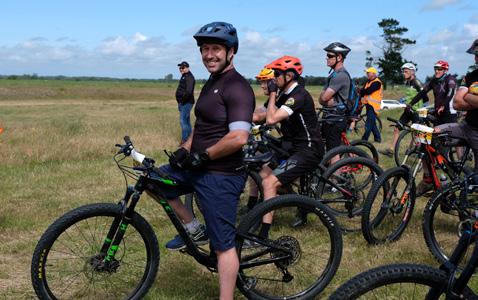
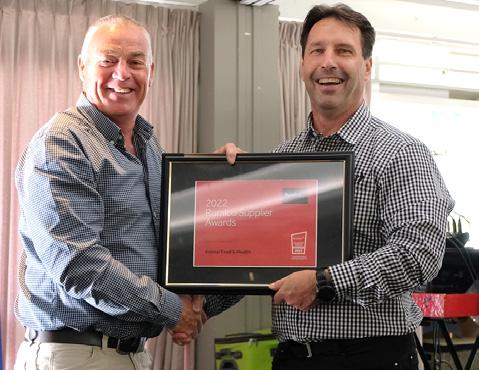

The cancellation of the proposed Lake Onslow pumped hydro battery project was a priority on the government’s early “to do” list as it took the reins of power late last year. WORDS BY
The $16 billion plus project would have been the country’s single largest infrastructure project ever, dwarfing even the extensive hydro schemes that dominated the development landscape of the 50s, 60s and 70s.
That cost and the decade long lead time were too large and too long for a government intent on balancing the books and delivering on election promises. So, on 3 December, Minister for Energy Simeon Brown declared Lake Onslow dead.
The project was intended to act as a back-up for New Zealand’s electricity supply, capable of providing electricity over “dry years” when the country’s hydro dam network’s supply is lowered by lack of snow and rainfall.
At present the bulk of the country’s base load supply comes via Huntly power station, a coal fired plant targeted for shutdown or alternative fuel use, given its contribution to 5% of the country’s carbon dioxide emissions.
RICHARD RENNIELow rainfall and lake levels can mean Huntly is called upon to boost supply, as in 2021 when it doubled its gigawatt hour output from coal compared to the 2020 financial year and was four times more than that emitted in the 2018 financial year.
A shortage in gas supply due to pipeline issues meant that despite its dual fuel capability, Huntly had been compelled to spend 95% of its time burning through coal fuel.
Genesis, owners of the plant have been aiming to reduce generation emissions by over a third by 2025, to remove about 1.2 million tonnes of carbon a year from its emissions profile.
Onslow offered a low emissions, “green” alternative to Huntly’s base load supply, with a high capital cost but relatively low operating cost profile, given its use of water rather than fossil fuel. Water would be pumped from the Clutha river into an enlarged Lake Onslow east of Alexandra
in Central Otago when power was cheap. Here it would be stored until required and then released through turbines in an underground power station to generate electricity as needed.
As the country’s largest ever hydro project the lake project would have been capable of generating up to 1,000mW of electricity, or over double the massive Clyde dam’s capability when all four of its turbines are running.
Lake Onslow would also have been capable of storing five terra-watt hours, equivalent to half a year of full production, and double that of Lake Pukaki’s storage.
The Lake Onslow project has loomed over the local community and New Zealand’s entire energy sector for the past five years as its possibility was mooted.
For locals in the small Central Otago community of Teviot there has been the

prospect for those farming around the lake their land would be flooded.
But the project had also bought hope for new jobs created in an area where seasonal employment in fruit harvesting dominates job options, and most young people leave the area for employment. The project’s construction was alone expected to generate up to 4,000 jobs.
Last year Energy Resources Aotearoa that represents the energy resources sector including oil and gas warned the decade long window to Onslow’s completion was simply too far out, with its presence making it harder for companies to justify investment in other generation assets.
As a switch to electricity from traditional higher emitting fuels continues, the sector could foresee a pinch on base load capacity. This would only be heightened by growth in solar and wind generation, neither which offer base load certainty given the variability of sunshine and wind speeds.
The association has pointed to independent reports showing there were more efficient pathways to deliver reliable, affordable sustainable energy options. A range of solutions across different generation methods and a cut
in the red tape to get them commissioned have been the recommendation of the sector.
Early in the new year it appears the government may have in part at least listened to these requests. The government has announced it intends to cut the red tape demands that sit around energy generation consents.
However, an alternative “portfolio” energy proposal also running alongside the Onslow project investigation is also due to cease. This was to investigate geothermal energy, biowaste, and other power options to reduce future power loss risks.
This proposal included government support for the construction of geothermal power stations acting as “standby” units for short supply dry years, along with the capacity in plants to burn wood waste, replacing coal and gas. Instead, officials are now due to work with Simeon Brown to determine priorities for a wider electricity system work programme that relates to supply and reliability.
Possible options that could be implemented quicker than Lake Onslow’s 10-year lead include adding grid-scale batteries to smooth out and store the energy flows from variable solar
and wind generation, and even the use of EVs’ batteries to supply the grid when not being used.
The continued use of fast starting, gas fired generation plants also provide a good, and relatively quickly built, standby.
Meantime Huntly, New Zealand’s base load stalwart generator has also successfully undergone trials using wood-based fuel in place of coal.
Last year the Canadian sourced wood pellets proved the plant could run on 100% wood fuel with a 90% reduction in emissions compared to coal.
Genesis has stated it wanted to develop a local biomass source for fuel. Its preference for this, along with another big energy user like Fonterra also seeking local biofuel could provide invaluable cornerstone catalyst for a local biofuel industry.
While the cost and lengthy time frame for Onslow has been acknowledged by all, what remains less certain is a clear plan from the new government on how the country’s need for sustainable, low emitting base load power in the meantime will instead be met. In absence of this, uncertainty will continue to hang over the market, as electricity demand continues to creep ever upwards.


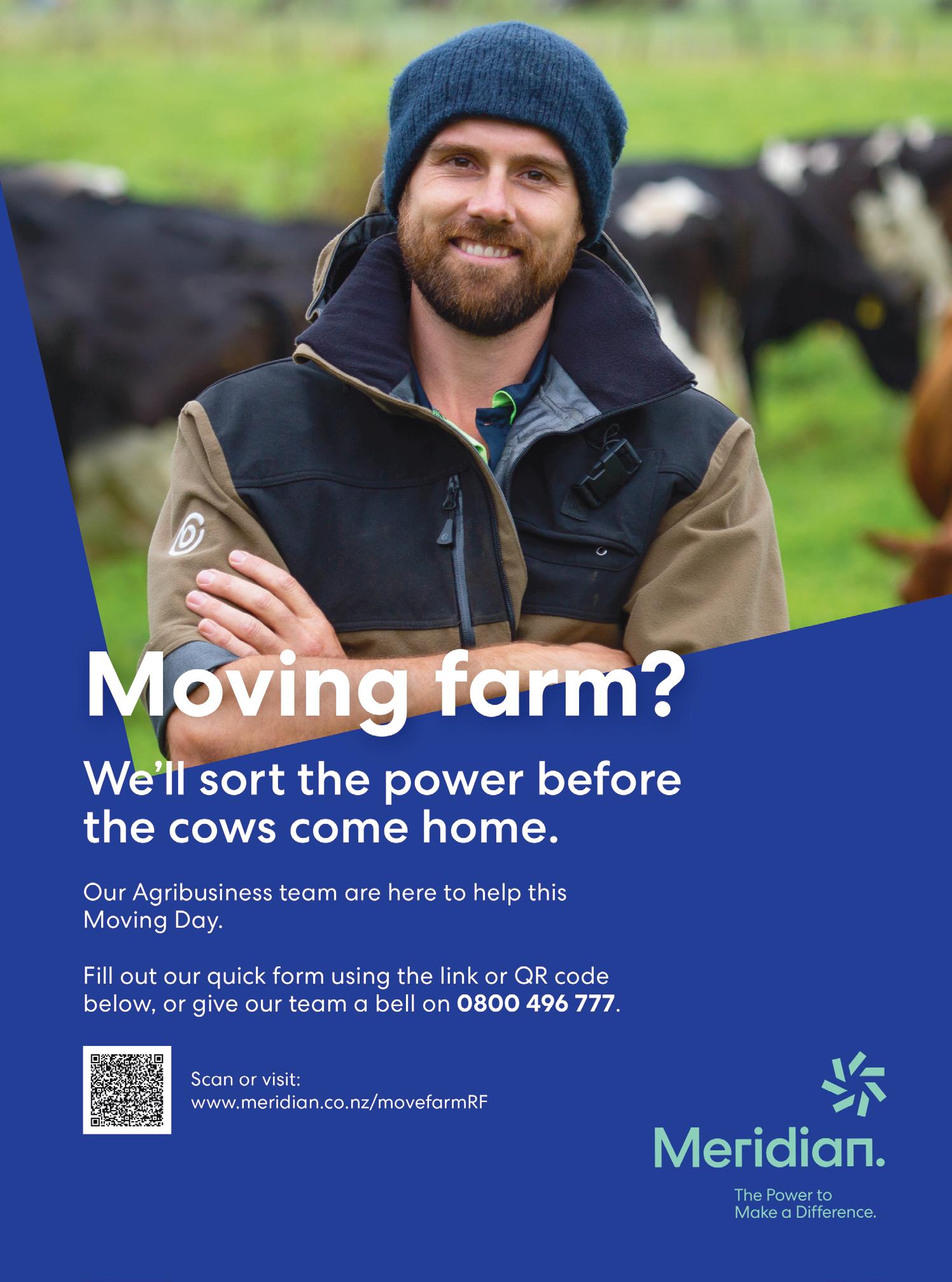
Two new Directors have recently been welcomed to the Ruralco Board bringing a wealth of experiences and farming knowledge to the table.
WORDS BY ANITA BODY, IMAGES BY TONY CARTERWHITE WOLF STUDIO AND SUPPLIED.Dave Barron, the current Managing Director of IT consulting and services business, Nectar Group Limited, based in Christchurch and director of farming enterprises, Tallarook Dairies and Rahi Partnership; along with Kate Beaumont-Smith, a Mid Canterbury dairy farmer who has been contract milking for the last four seasons and was formerly a lawyer both locally and in the UK, were elected unopposed.
As per the Society’s rules, current Chair, Sir David Carter retired by rotation. He was available for re-election and was duly re-elected.
The two new Directors filled vacancies created by the resignation of a sitting Director earlier in the year, and a new vacancy created by the Board, following a decision to widen the Board’s skillset and increase the number of Directors. This means there are now six elected Directors: Sir David Carter, Kate Acland, Rhea Booker, Tony Coltman, along with the newly elected Dave Barron and Kate Beaumont Smith.
Finding a role which combines a love of farming and the ability to flex her legal and governance skills were behind Kate Beaumont-Smith’s decision to stand for the Ruralco Board of Directors.
It was a case of second time lucky, after the former lawyer turned contract milker from south of Hinds, Mid Canterbury was elected unopposed at the November Annual General

Meeting last year after previously vying for a place on the Board at the 2022 election.
“I really wanted to do something that was a hybrid mix between law and farming.”
She describes joining the Ruralco Board of Directors as a great way to be involved in a cooperative which she has admired during her time in Mid Canterbury. “I’ve always felt it’s a good, established, local business and I like that it is prepared to support and supply locals, and that it is run by farmers for farmers.”
Originally from the UK, Kate has been in New Zealand for almost 10 years, based solely in Mid Canterbury. Prior to moving to New Zealand Kate worked as a lawyer mostly with private clients, with her area of practice predominantly being wills, estates, and trusts. She continued working in similar roles when she moved to New Zealand in 2014 until deciding to give it up in favour of working on the farm.
“Now I’m on the farm doing calf rearing, and a variety of admin tasks like the bookwork and staff management.”
She and her husband, James, are contract milkers with 565 cows and operate the farm’s run-off block. Originally from Doubtless Bay in the far north and after serving in the New Zealand Army, James was already farming in Wales and it’s through those connections the couple ended up in Mid Canterbury, with the best man at their wedding also hailing from the UK and now settled in the district.
Family and community is important to Kate and James. The couple have two daughters, Lexi 7 and Holly 5, who both attend Hinds Primary School and are playing rugby for the local Southern Rugby Club. The girls are also involved in Brownies, Pippins, swimming, and Lexi also shares her father’s passion for golf. As a member of Hakatere Ceramics & Pottery Ashburton, Kate gets to indulge her creativity by making pieces for friends and family. “I have a very organic, free form style and I don’t do wheel work. I like to include other materials such as melting glass in my pieces.”
Kate has a strong desire to give back. As the parent of a daughter with Turner Syndrome, Kate is not only the treasurer on the national board (the Turner Syndrome Association of New Zealand), but was instrumental in creating a governance structure, writing a new constitution, policies, and procedures, as well as implementing financial systems.
Turner Syndrome affects women and girls who have a missing or partial X chromosome and affects one in 2,500 female births. Next

year the national organisation, in conjunction with its Australian counterpart, is hosting a world-wide conference, which she says is very exciting and will keep her and the national board busy.
Kate is looking forward to continuing her work as a Ruralco Director and appreciates having the opportunity to give back to the farming community and continue to grow professionally, while also working around her family commitments.
“I’m really enjoying my director role. In the UK I was involved in a lot of tax advice and planning, especially around things like inheritance tax.
That’s not part of a lawyer’s role in New Zealand (to provide financial advice), so it’s been great to be involved in the financials and to see the logistics around what makes Ruralco tick.”
DAVE BARRON
Growing up on the family farm on the north side of the Rakaia River instilled in Dave Barron a life-long love of the great outdoors and farming. It would have been logical to assume a career in farming beckoned, but the economic downturn
in the late 1980s and early 1990s took him down another path instead.
The newly elected Ruralco Director says while at St Andrews College, his top marks were in the agriculture course “but I decided to not go into farming because of it being in the doldrums at that time. Instead, I went to Christchurch to begin a career in accountancy, going straight into the workforce and studying part-time.”
Dave began work as a costing clerk with manufacturing business, Moffat Appliances, and by the early 1990s discovered computers. “My time at Moffat Appliances gave me exposure to manufacturing processes and provided an excellent foundation to develop my IT career.” He then moved to Ernst & Young’s computer department where he installed and configured accounting applications for various companies from a variety of sectors and industries. “It gave me the opportunity to set up and experience many computer systems. At that time, computer courses were only in their infancy—you could learn more on the job than through anything else,” he says.
From there, Dave went to CommArc Consulting where he moved back into an infrastructure role as an IT consultant, and later progressed to become the General Manager. He spent 13 years with the business before moving to The Laptop Company, again in the GM role, seeing through the difficult challenges of the GFC (global financial crisis) and the Christchurch earthquakes.
He was also seconded throughout this time to undertake project work for a variety of clients, including Connetics and Fonterra. Career highlights included the project management of the implementation of a milk collection data system for Fonterra which included over 500 trucks and 1500 drivers over seven sites. “It was really hard work but we got it done and it was very successful.”
Currently Dave is a director and controlling shareholder of Nectar Group Ltd, having started the business in 2012. In simple terms, the business specialises in designing, installing and maintaining client’s computer systems. Nectar has lots of fantastic customers in and around Ashburton, giving Dave a good understanding of the district and a greater understanding of Ruralco and the communities it serves.
He quips he has promoted himself out of harm’s way by appointing a GM to grow the business. This gives Dave more time for his latest venture, e2e Limited, which focuses on helping organisations to optimise process and software applications to improve business efficiency and profitability.
“I’m in my happy place when I’m consulting and assisting businesses, especially agricultural ones.” He says it almost feels like he’s come full circle, although in reality, he has never lost his connection to farming. “I’m a director for the family farm. When we converted to dairying in the early 2000s, we were part of Spectrum Dairies and built some great relationships.” Now the farm is in a partnership ownership arrangement, with Dave’s father still owning the land.
Family is important to Dave and his wife, Tracy, and their two children—Emily, 22, and Elliot, 18. Freeing up some of his day-to-day business commitments means he can take up opportunities, like recently tackling the Kepler Track with his daughter.
It also means he can” give back”. “I can take the time to focus on strategy and governance, and bring my IT, management, and governance skillset to the table, like I do in my role on the Ruralco Board.” He’s also a councillor for North Canterbury Fish and Game and says it’s a great way to blend his passion for the outdoors and farming.
“It’s my belief that Fish & Game can and should work alongside farmers. Farmers are caretakers of the land and they understand that. We are more aligned than some might think and it’s really important that we have a great relationship.”
ABOVE: David Barron and his daughter Emily taken atop a foggy Mt Luxmore at 1,472m
OPPOSITE: Kate Beaumont-Smith and her husband James, daughters Lexi and Holly, and her constant companions, chocolate labradors, Frank and Doug
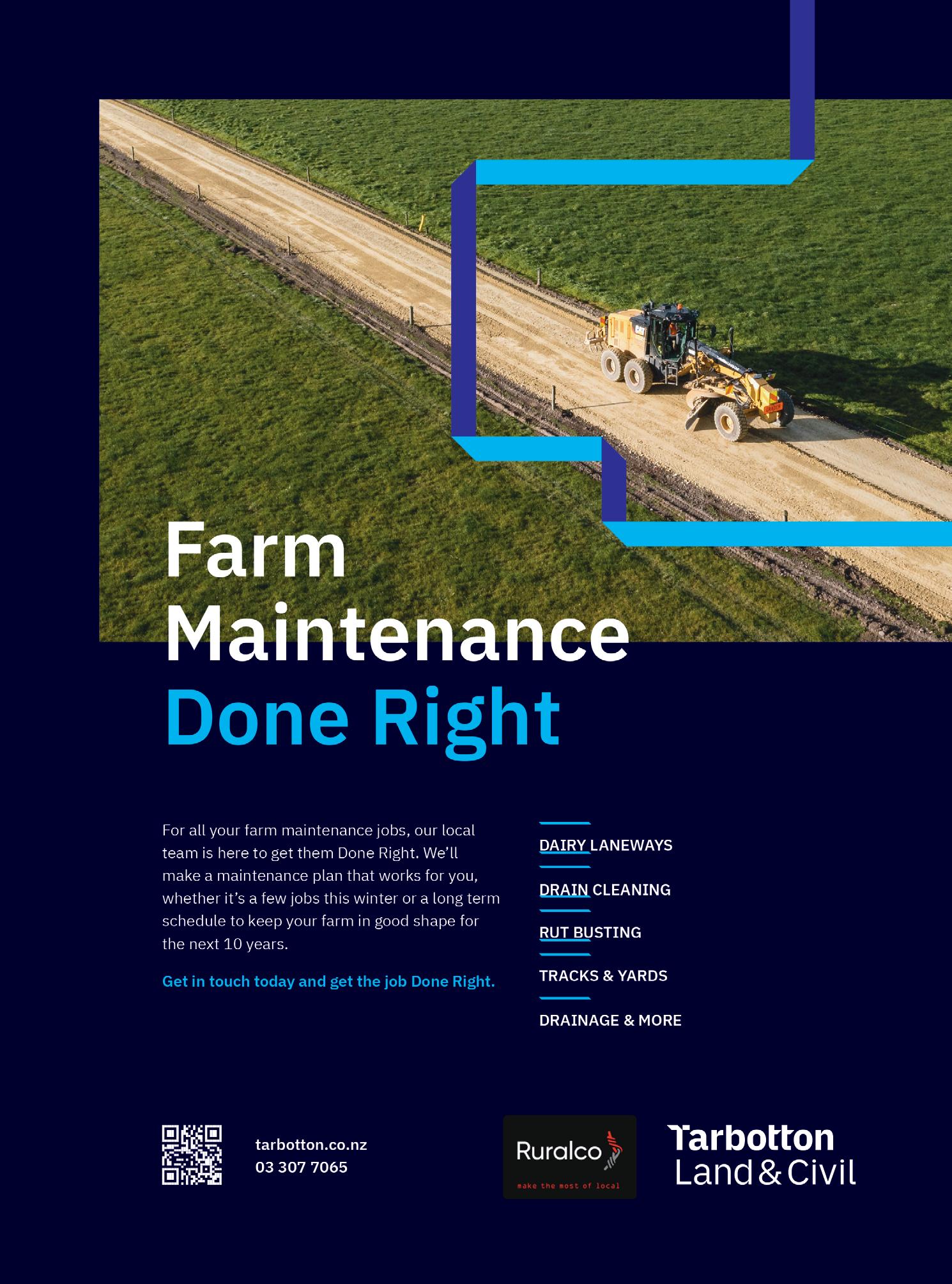
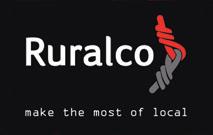
Manta Italian ryegrass is the latest diploid Italian ryegrass from Agricom. Manta has an explosive establishment speed being the fastest starting genetics we have seen to date. This fast establishment allows farmers to plant with confidence, growing quick feed before winter sets in.

Often Manta can be mistaken for a tetraploid Italian, especially through winter and spring.
Manta is a late heading diploid Italian ryegrass with an upright habit, medium tiller size, and broad leaves and has a very similar heading date to Asset (+ 12-15 days, exact date still to be confirmed). Being Agricom’s highest yielding diploid Italian means more grass grown for meat, milk and supplement production and is also an ideal product for undersowing into thinning or run-out pasture.
Manta is a new generation of Italian ryegrass that has undergone significant selection in the upper North Island and includes genetics from short term ryegrass ecotypes (some possibly hybrids) from Northland. Alongside this Northern New Zealand ecotype material, Manta has parents from a core pool of successful New Zealand Italian cultivars as well as genetics from Spain making it a diverse and exciting addition to Agricom’s ryegrass portfolio.
Manta was originally bred with AR37 however it has first been commercialised in Australia as a fast starting Italian without endophyte. The AR37 multiplication was delayed in New Zealand and is due for release in 2023/24.
Manta is a long lived Italian with strong potential for persistence beyond its first year. Survival of Manta through a second summer
is dependent on region and Argentine stem weevil populations.
Manta is a new Italian ryegrass, and with AR37 endophyte is a fast establishing highly productive variety which is a recent addition to the AR37 endophyte line up. Manta AR37 stands out as an excellent choice for undersowing into damaged pastures,
leveraging its quick establishment and robust growth offering a dependable solution for such scenarios. It should be noted that Manta AR37 may cause ryegrass staggers. Manta AR37 is only for beef and dairy farms.
THIS PROMOTIONAL FEATURE WAS PROVIDED BY AGRICOM

What you’ll need:
A glass jar or clean tin
Hot glue gun
Jute twine (natural or coloured, or a combination of both)
Scissors
What to do:
Plan out the pattern for how you want your twine to cover the vase.
Heat up your hot glue gun. When it’s ready, apply a line of glue to the bottom of your jar and press in the end of your twine. Let it set before beginning the next step.
Wrap the twine tightly around your vase, working from the bottom up. When you’re finished with that colour or have achieved the height of twine you want, cut the twine and apply another thin line of glue to secure it to the glass.
Repeat steps two and three with each new colour of twine you want to use.
Top tip
You only need to apply enough glue to allow the twine to adhere to the glass surface. Excess glue will be visible once hardened.


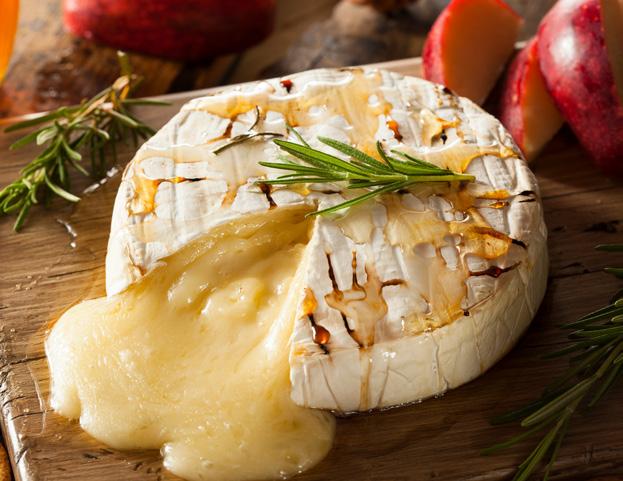
INGREDIENTS
Brie wheel (160g – 220g)
2Tbs honey
Spring of thyme
Salt to season
Crackers or bread to dip
Chutney (Optional)
METHOD
Preheat oven to 180ºC.
Unwrap your brie. Using a knife score the top, cutting approximately 1cm deep.
Place brie into a baking dish or cast-iron pot scored side up, drizzle with honey and a sprinkle of thyme and salt.
Place in the oven for about 10 minutes. The brie will be melted and almost ready for you to enjoy.
Serve with crackers or bread, enjoy as is or combine with chutney for a more complex flavour.
MARCH :
As we move from one season to the next, this month is all about that change: Harvesting the last of summer crops, and preparing for autumn and winter.
Key Points
• Mow lawns more regularly and feed with lawn food as rain becomes more frequent
• The first of the season’s cyclamen will appear in store this month. Remember to keep in a well-lit room that has a cool even temperature.
• New season’s Camellias are now coming into the store. The perfect shrub for winter colour in the garden
APRIL
Key Points
• Strawberries
Now’s the time to be planting strawberries. Strawberries like good fertile soil so dig in lots of top quality compost before planting. A handful of Blood and Bone in the planting hole and a top dressing of general fertiliser will get them off to a flying start. Remember to water in well after planting. Strawberries look great in strawberry pots on the deck – easy picking in the summer!
• Vege Garden
Still lots to do in the vegetable garden this month. Spinach, cabbage, winter lettuce, bok choy, should all be part of your winter garden.
Broad beans are a great winter garden crop – plant seeds now into prepared soil. Provide some support as they do get reasonably tall (use twigs and small branches from your pruning in the garden). Broad beans are easy care, and you will have delicious young beans in October / November.
Shallots – sweeter than garlic, milder than onions. Great in stews and casseroles, or roasted whole. Shallots are easy to grow and take up little space in the garden.
Rhubarb – Nothing beats the taste of homegrown rhubarb with your muesli or weet-bix for breakfast! Rhubarb is planted by ‘Crowns’ which are available this month.
Rhubarb plants are heavy feeders so dig in plenty of top quality compost at planting time and follow up with general garden fertiliser at regular intervals through the year.

Key Points
• Spray lawns with Yates Turfix to control broadleaf weeds, and Yates Surrender to get rid of moss.
• Prune back shrubs that have finished flowering and feed with a fertiliser high in potash such as Rose fertiliser.
• Lift and store dahlias and gladioli.
• Plant lily bulbs now.
• Spray deciduous ornamental and fruit trees with Lime Sulphur. This stops lichen from growing and helps control overwintering diseases and insects.
• Protect young seedlings from slugs and snails with Quash or Baysol snail pellets.
For more gardening advice or products, visit www.lushingtons.co.nz and don’t forget your Ruralco card when shopping in store!


The kitchen is referred to as the heart of the home, a place for gathering with family and friends and making memories. So why not show your personality and reflect your own style, taste, and lifestyle at the core of your living space. We’ve crafted a 5-step guide to help you strike the perfect balance between style and functionality.
Choose items that serve a purpose such as salt and pepper mills, wooden boards, cookbooks, candles, and diffusers. Kitchen scents are the perfect way to give your space an element of luxury and ambience but can also mask any unwanted cooking smells.
The kitchen still needs to be a functional space and remain free of clutter for everyday use. Organise your items within easy reach of your most used cooking space and leave the rest of your bench clear for meal preparation and easy cleaning.
Bring the outdoors in with foliage, plants or potted fresh herbs. Plants can improve air quality which has been proven to reduce stress and boost your mood. Our favourite is the ZZ Plant (Zamioculcas zamiifolia), celebrated for its low maintenance needs and adaptability to varying light conditions, from dim corners to well-lit spaces. (Just remember to shield them from direct sunlight for optimal growth).
Mix and match different colours, shapes, and textures to reflect your personal style. Pair sleek salt and pepper mills with organic wooden boards to create an eclectic and purposefully curated look.
Using objects that vary in height can create dimension to your look. If in doubt, use the rule of threes, clustering trios of objects together in different heights. Arrange taller items such as vases and plants at the back and your smaller objects in the front. Stack items on boards, books or pedestals to create an elevated look.
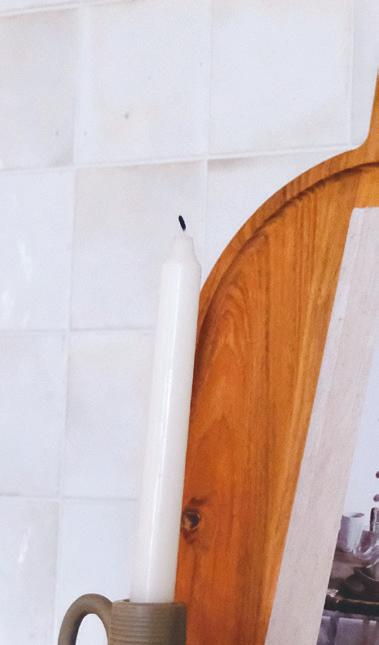
And most of all, have fun with your space, change it up with the seasons and make the most out of the heart of your home.
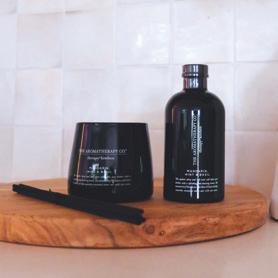



From pressure cooking to slow cooking, sautéing to yoghurt making, the Instant Pot Duo Plus is your 13-in-one kitchen companion. Create delicious meals with ease during the busy winter period, you can even bake cakes and desserts. Check out some of our favourite recipes from Instant Pot.
INGREDIENTS
2 tablespoons olive oil
1/3 cup shallots chopped
8 ounces Swiss brown mushrooms sliced
1/4 teaspoon salt
1/8 teaspoon crushed red pepper
2 cloves garlic minced
2 cups vegetable stock or chicken stock
1 cup Arborio rice
1/4 teaspoon dried thyme
1 tablespoon butter
2 cups baby spinach

1/3 cup Parmesan cheese freshly grated
METHOD
Select sauté on the Instant Pot and adjust to normal. Add oil to pot. When oil is hot, add shallots and cook for 2 minutes to soften, stirring occasionally.
Add mushrooms, salt, and crushed red pepper; cook for 4 minutes or until mushrooms are tender, stirring frequently. Add garlic; cook and stir for 1 minute more. Press cancel. Add broth, rice, and thyme. Secure the lid on the pot. Close the pressure-release valve. Select Manual and cook at high pressure for 6 minutes. When cooking is complete, use a quick release to depressurise. Add butter and spinach to rice mixture; stir to wilt spinach. Stir in Parmesan cheese. AVAILABLE


INGREDIENTS
2 cups white wine
2 cups orange juice
½ cup Water

¾ cup honey I used organic honey
1 cup sugar
Vanilla bean (can substitute with a drizzle vanilla extract)
1 cinnamon stick
Star anise
2 cloves
½ orange
4 Bosc or golden pears
1 Lemon
1 tsp corn starch
1 tbsp butter
French vanilla ice cream to serve
METHOD
Place the stainless-steel inner pot inside the Instant Pot®. Press sauté and set time to 10 minutes. Add the white wine, orange juice, water, honey, sugar, cinnamon, star anise, vanilla, cloves, and orange. Mix and wait for it to boil.
Meanwhile, peel the pears and cut the bottoms a little so that they can stand up easily. Squeeze lemon juice over the pears to prevent browning. When the liquid begins to boil, add the pears.
Close and lock the Instant Pot® lid. Make sure the steam release handle is turned to Sealing. Press Pressure Cook, pressure level High, and set time to 10 Minutes. When done cooking, release steam, remove pears from pot and set aside (pears are done if a knife goes in easily, leave a little longer if necessary).
Strain the liquid and return to the pot. Press sauté for 25 Minutes. Let liquid reduce until a syrup forms. (I added 1 tsp corn starch dissolved in a bit of water). After 25 Minutes, turn off and add butter. Mix. (When the syrup cools, it thickens)
Serve the pears with the sauce on top and French vanilla ice cream on the side.
In the summer of 2014, Bernard Jordan (Michael Caine) made global headlines. He had staged a great escape from his care home to join fellow war veterans on a beach in Normandy, commemorating their fallen comrades at the D-Day Landing 70th anniversary. It was a story that captured the imagination of the world as Bernie embodied the defiant, can-do spirit of a generation that was fast disappearing. But of course, it wasn’t the whole story. It was an inspirational but sanitised retelling of one man’s need to come to terms with the lasting trauma of war.

USE YOUR RURALCO CARD HERE

In a switch from the typical genre, Madame Web tells the standalone origin story of one of Marvel Publishing’s most enigmatic heroines. The suspense-driven thriller stars Dakota Johnson as Cassandra Webb, a paramedic in Manhattan who may have clairvoyant abilities. Forced to confront revelations about her past, she forges a relationship with three young women destined for powerful futures, if they can all survive a deadly present.




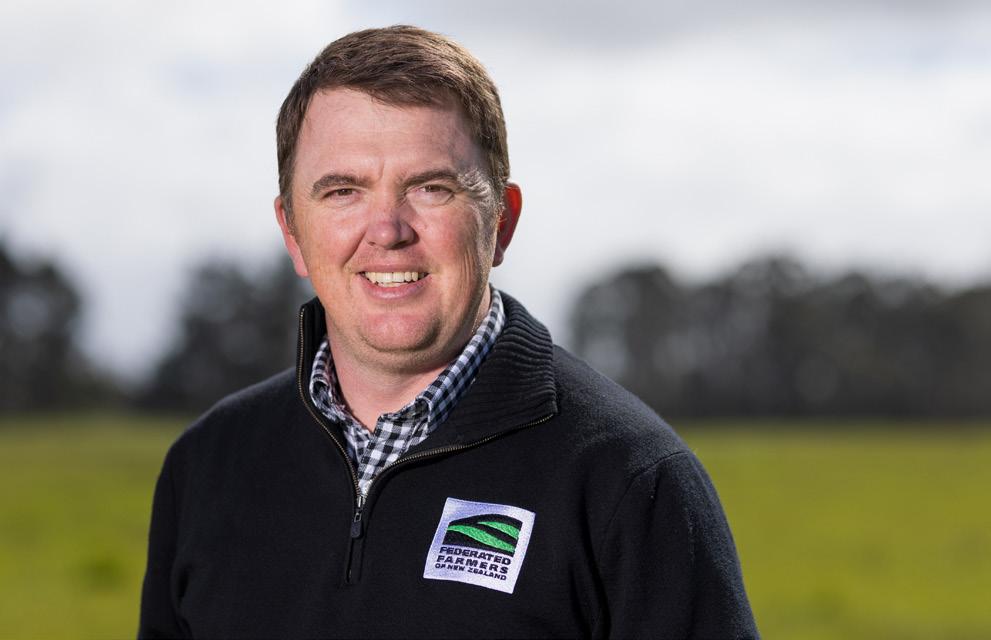
Just like players on a rugby field, agricultural groups need to be clear on their specific roles and play them well if we want to win, Federated Farmers national president Wayne Langford says.
WORDS AND IMAGES SUPPLIED BY FEDERATED FARMERS
Six months into his role as president, Langford says uniting the sector as one team, ensuring everyone is playing in the right position, is one of his main goals for 2024.
“I’m a coach of the local under-16 boys’ rugby team and I tell my boys every Saturday before they hit the park, ‘just do your job well and we’ll get a win out there’.
“That same idea applies in the ag sector too. We’ve all got our own jobs to do, and we need to make sure we’re not cutting across in front of each other. Otherwise, we’ll knock the ball on and farming ends up losing.
“That’s what I really want to work on in 2024, making sure everyone is working together, sticking to their own jobs and doing them well.”
Before last year’s General Election, Federated Farmers released 12 policy priorities for the new Government, and seeing those policies implemented is another focus for Langford this year.
“We’re really disciplined and clear about what we wanted from the incoming Government with our 12 key policies to restore farmer confidence.
“That discipline and clarity paid off. The Coalition Agreements between National, ACT and New Zealand First had Federated Farmers’ fingerprints all over them.
“That’s a pretty awesome result for a farmer advocacy group, and for farmers as a whole, but the job’s only half done.
“My focus now needs to be making sure the Government actually follow through and deliver the change they’ve promised to farmers and rural communities.”
Speaking on the newly launched Federated Farmers Podcast, Langford also discussed his mission to see Federated Farmers operating at its best as well.
“My team will get sick of me hearing it, but Feds are quite a big organisation and it’s so important that we’re working as one team for farmers.
“If we want to achieve all the things farmers are expecting us to, we need to be performing really well. That needs to be across the board, from the small meetings we do in the provinces right through to the big crunch moments when I’m sitting in front of the Prime Minister.”
Langford says he takes the presidential role very seriously, especially given farmer confidence is at an all-time low, and he’s well aware of the negativity that can exist within and around farming.
Even so, he’s determined to bring more positivity—and his own brand of humour—in his remaining two-and-a-half years as president. “I battle with that a little bit. Being a Federated Farmers president is a huge honour and it is a highly regarded position within the farming community. There’s an expectation that you will act kind of statesman-like. That’s meant I’ve needed to tone back some of my jokes and banter at times.
“I’m also really working to bring back some optimism for the sector.
“I’m extremely positive about the future of farming and where we’re going together, but I’m also proud of our history and where we’ve come from. So, I’m hoping that kind of flows through.”
Farmers who want to share their thoughts with Langford or Federated Farmers shouldn’t hesitate to pick up the phone, he says.
“Federated Farmers is a ground-up organisation. We are here to hear the farmers’ voice, so don’t ever feel like you can’t reach out.
“It’s really important to me that I’ve got the members’ voice behind me. So, if you’re ever sitting on the tractor and you want to get in touch, please do it, because I’d really appreciate the feedback.”
Hear the full conversation with Wayne Langford on episode one of the newly launched Federated Farmers Podcast, on Spotify, Apple or wherever you listen to podcasts.
ABOVE: Federated Farmers National President Wayne Langford
BELOW: Getting the ag groups working well together is a major focus in 2024 for Wayne Langford (centre), pictured with Federated Farmers Board members
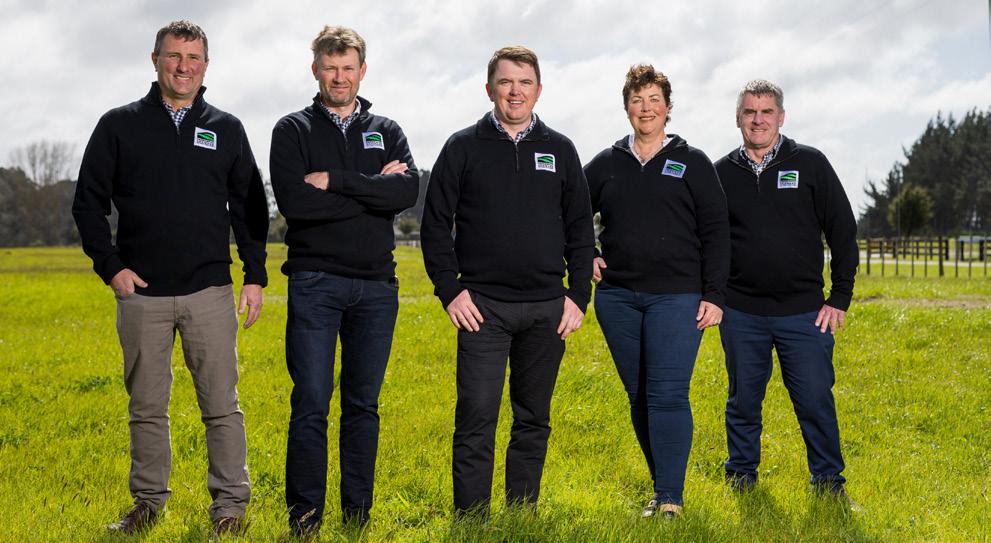
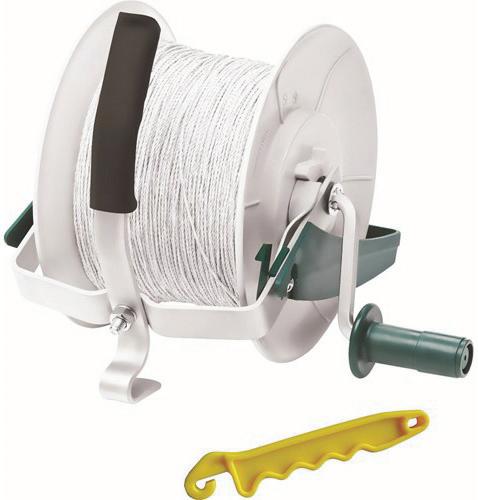
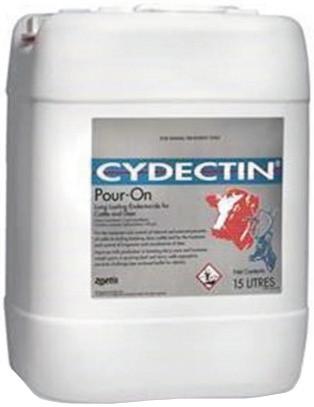





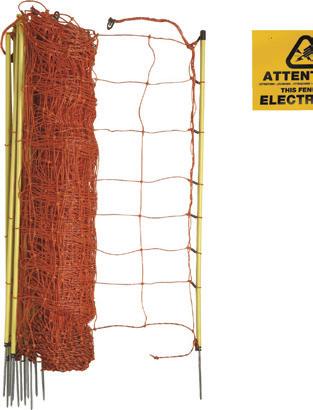
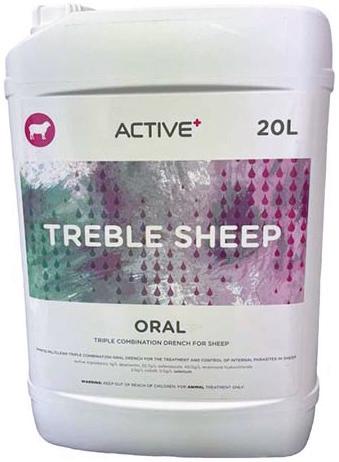
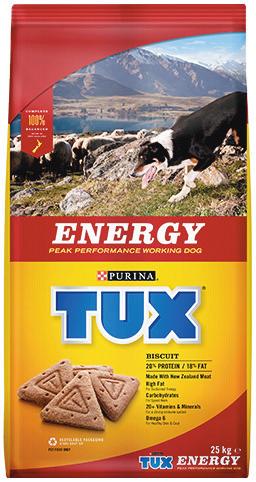






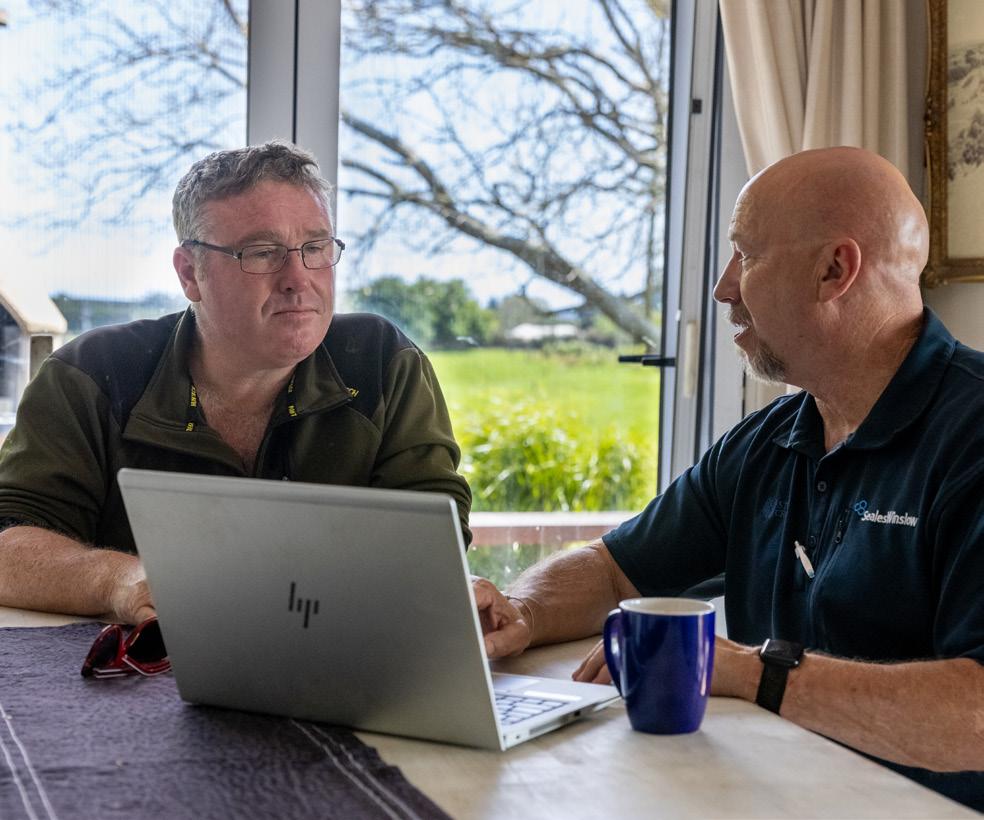
Dairy farmers can now accurately measure return on their feed investment and weigh up supplementary feed options to maximise returns using a new digital tool by SealesWinslow.
Ruminix³ by SealesWinslow is a science-based tool tailored to New Zealand’s pasture-based farming operations. Used by SealesWinslow at no cost to farmers, Ruminix compares the effects of different feed combinations on milk production based on the variables of each farm’s unique system.
Using the tool, SealesWinslow has demonstrated farmers could generate up to 30% more income simply by using the right supplementary feed.
SealesWinslow General Manager Grant Jackson says as costs continue to rise and the summer continues to be unpredictable, dairy farmers are looking for cost-effective ways to put milk in the vat and keep their cows in milk.
“Dairy farmers need a straightforward way to work out how to maximise milk and safeguard the profitability of their business long term.
“Instead of making feed purchasing decisions solely based on price, which is not always best, dairy farmers can now rely on Ruminix³ to expand their options and reduce risks by predicting the
effects of different feed choices before making a purchase.”
Using nutrition modelling based on the Cornell Net Carbohydrate and Protein System (CNCPS) and NASEM (NRC), Ruminix³ demonstrates the possible return on investment from any feed simply by inputting variables such as kilograms of dry matter (kgDM), metabolisable energy (ME) and starch content.
CNCPS based systems are used by nutritionists in New Zealand and is widely accepted as an accurate predictor of milk production in
pasture-based systems. SealesWinslow has also been modelling case studies using Ruminix³. A 500-cow dairy farm in the South Island producing 1.76kgMS pe r cow per day feeding 18kgDM from pasture and 3kgDM from PKE, showed a predicted income over feed cost of $54,900/month, at a $6.75kgMS payout.
If that same farm fed a combination of 18kgDM from pasture and 3kgDM from a high starch (50%), high energy (13.5 MJ/kg) pelletised feed, feed costs increased by 16%. However, milk production increased by 20% and the farm’s predicted income over feed costs jumped to $72,788/month. An income increase, of more than 30% each month.
Grass will always be king. However, SealesWinslow Nutrition & Quality Manager, Paul Drew says seasonal variability in pasture means there will be times when there are seasonal shortfalls between nutrition needed and what pasture can provide.
“Ruminix³ by SealesWinslow can help farmers predict their herd’s response to different feeds at each stage and identify the best solution to maximise production and boost returns.
“Ruminix can help strategically fill ‘grass gaps,’ ensuring each animal is getting the right nutrition at the right time and farmers are getting the best return on investment. Best of all it is simple to use and coupled with the guiding hands of our team will give farmers confidence the solutions they choose will give them the best bang for their buck,” says Paul.
Ruminix³ is used by the SealesWinslow team via a tablet or laptop. Farmers can receive easy to understand reports, which can be customised based on their individual needs.




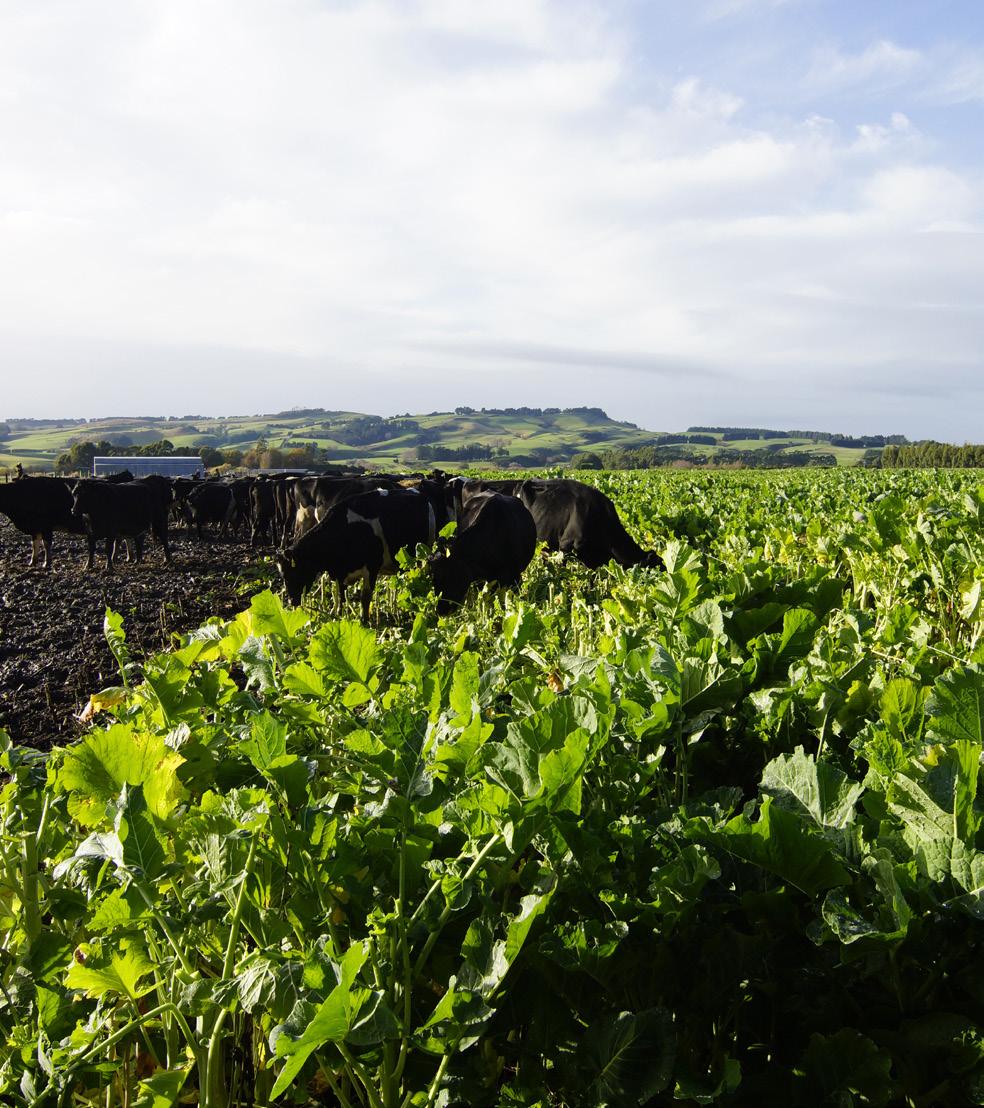
While many of us aren’t quite ready to say goodbye to summer, we do need to look ahead and start planning for winter.
WORDS AND IMAGES SUPPLIED BY JUSTIN KITTO, DAIRYNZ LEAD ADVISORI am continually impressed by the efforts of farmers putting good wintering practices in place, ensuring they care for their animals no matter the conditions. There is good work happening on farm, and our recent DairyNZ wintering survey emphasised this, with some great achievements, including:
• The proportion of farmers with written wintering plans has improved, increasing to 80%.
• There has been a significant increase in the proportion of farmers with a written contingency plan.
• 74% of farmers implemented at least five good management practices to support their cows and manage winter conditions.
• 96% of farmers said they had strategies to provide comfortable lying conditions.
Another finding from last wintering season was that the use of portable troughs and back fencing had a lower uptake rate and hasn’t increased over the last three seasons. They are options to consider should you be looking to lift performance on your farm this winter.
The benefits of portable troughs and back fencing
I have seen the benefits of using these on several farms and encourage all farmers to consider how they can add them into their winter plans.
The two main benefits farmers talk about both relate to better soil conditions:
1. Paddocks dry out sooner—you can get equipment in early and get something else growing more easily.
2. Soils are less damaged by cows moving back and forth, so when the wet weather does arrive, back fences can be extended or dropped to provide more area to cows to aid lying time.
For those concerned about the added hassle of using portable troughs, there are some great number 8 wire solutions recommended by farmers who have used them successfully.
Creative ideas include the installation of skis for ease of movement; putting the troughs under fences from neighbouring grass paddocks to avoid dragging through mud; and putting the troughs on trailers.
Portable troughs and back fencing are part of a great winter tool kit to help provide comfortable lying surfaces for as long as cows want to lie down. Since cows require a minimum of 8 – 10 hours of lying time per day, it’s important to ensure that conditions are sufficient for them to lie comfortably when they want.
The range of strategies available include shifting them to a drier, lower risk paddock, or using crops positioned in drier or more sheltered areas for grazing during bad weather.
A question for some may be, “how do you decide when the conditions aren’t right for sufficient lying time?”. The gumboot score is a tried-andtrue method; however, we have heard of a few other quirky but sensible ways of identifying this. “If the mud pulls your red bands off, it is too wet for the cows to lie on”. Or “If I won’t lie down in that paddock, I shouldn’t expect my cows to lie down in it either”.
Whatever your strategy for identifying a comfortable lying surface, it is important to have a firm boundary in mind for when you need to implement a contingency plan.
Outline what these are in your written wintering plan, including your portable trough and back fence strategy, then share it so everyone is on the same page before the cold weather arrives. More information is available at dairynz.co.nz/ wintering
 JUSTIN KITTO DAIRYNZ LEAD ADVISOR
JUSTIN KITTO DAIRYNZ LEAD ADVISOR

Ryegrass seed crops are commonly followed in the rotation by an autumn cereal such as wheat.
WORDS AND IMAGES SUPPLIED BY ABIE HORROCKS, FOUNDATION FOR ARABLE RESEARCH
However, this option is growing increasingly challenging in some areas due to herbicide resistance in ryegrass. An alternative approach is to maximise the benefits of the ryegrass seed crop by using the re-growth as the basis for a winter feed crop.
In 2022/23, FAR investigated the viability of sowing legumes into ryegrass re-growth to a) extend the value of the crop by providing high quality feed and b) reduce the N fertiliser spend for the next year (nitrogen fertiliser costs frequently make up more than half of farm expenses).
Two trials were used to assess drilling legumes into ryegrass re-growth.
1. The Chertsey Establishment Trial (CET) measured biomass and N supply from adding faba beans (Vicia faba L.) to ryegrass regrowth under different tillage and irrigation scenarios.
2. A trial at Kowhai farm compared establishment of small and large seeded legumes over-sown into ryegrass re-growth (biomass and quality were measured).
At the CET, harvest was completed by 2 February 2023 in the dryland ryegrass plots and by 12 February in the irrigated plots. Faba beans were direct drilled at 60 kg/ha on 3 March into ryegrass re-growth. The trial was grazed by autumn born R1 dairy calves for 4 days from 27 April.
At Kowhai, four legume species were oversown into the ryegrass re-growth on 6 April 2023. Three of the varieties were small seeded (<100g per 1000 seeds); Berseem (Trifolium alexandrinum L.), Balansa (Trifolium michelianum) and Hairy vetch (Vicia villosa)) and one, Faba bean was large seeded (500–700 per 1000 seeds). They were sown at 7, 4, 40 and 40 kg/ha,
respectively. Biomass assessments from each plot were carried out 16 August. The four legume plots were compared with controls of annual (cv. Tama) or perennial (cv. Base) ryegrass re-growth.
There were no significant effects of tillage or irrigation on ryegrass seed yields (average 1660 kg/ha). Faba beans were direct drilled into the ryegrass re-growth during very dry conditions. This was noticeably problematic in the dryland replicates and no-till plots (desired seed depth was 5 cm but actual depth was variable, 1-3 cm).
Three months after grazing, there was significantly greater faba bean re-growth in the irrigated plots (48%) compared with the dryland plots (17%).
There was very little soil mineral N in the top 50 cm after the ryegrass harvest (7.4 kg/ ha; range=5–13 kg N/ha) and soil mineral N remained low three months after the grazing event, averaging 3.8 kg N/ha (range=3–6 kg N/ ha). Despite low soil mineral N, there was 39 kg
N/ha in the above ground biomass pre-grazing, on average. Some of this would have been removed by grazing, some would have remained un-grazed, and some would have been returned via dung and urine. Three months after grazing there was on average 41 kg N/ha in the above ground biomass.
Given that no fertiliser N was applied, and that soil mineral N was low at drilling, this N came from further mineralisation and N fixation generated from the faba beans.
At the Kowhai trial site, the large seeded faba bean established well, but the small seed legumes (vetch, balansa and berseem) failed to establish. As the ryegrass at this site had re-grown, this lack of establishment is likely to have been caused by either reduced soil/seed contact (due to the difficulty in adequately drilling the smaller seeds into the soil) or the reduced ability of legume seedlings to compete with the already established ryegrass. Dry matter quantity and quality (e.g., crude protein) were greater for the faba bean/ ryegrass mix compared with the ryegrass control.
Over-sowing post-harvest ryegrass re-growth with a legume resulted in greater biomass and improved quality (compared with re-growth without a legume), however the timing of drilling and soil conditions at sowing are important. Dry and firm soil conditions may affect success of over-drilling larger seeds, while smaller seeds may struggle with competition from the ryegrass regrowth. Further work on the impacts of drilling the smaller seeded legumes earlier is required to better understand these dynamics.
Residual soil mineral N was low after the ryegrass seed crop was harvested but continued mineralisation of N carried the grasses through, while the legumes were expected to fix most of the N they needed for growth. Little is known about the benefit of N fixation to the companion crop; this is another area that requires further work.
As the legumes decompose in the subsequent spring crop further N advantages are expected and soil testing (PMN) would be recommended to ensure this is capitalised on.

North Otago mixed arable farmer
Peter Mitchell says he is reconsidering where ryegrass fits in his rotation and is looking for ways to extract more value from the crop.
WORDS AND IMAGES SUPPLIED BY HEATHER CHALMERS, FOUNDATION FOR ARABLE RESEARCH.
With limited crop options, ryegrass has been a “poor man’s break crop” on his farm before going into wheat, Peter says.
The rolling downs property near Oamaru grows wheat, barley, ryegrass, and radish, as well as sunflower and canary seed for the family’s bird seed business. About 140 beef cattle are finished as well as 4000 to 5000 lambs in winter.
Other potential crop options like maize or clover seed can’t be grown because the farm’s location doesn’t have the heat units for reliable economic yields and heavy clay soil makes harvesting difficult. The heavy clay also rules out peas. Burning of crop residue is not an option because of the number of lifestyle blocks and roads near the farm.
In a presentation at FAR’s ARIA event at Chertsey, Peter said he was interested in the results of a FAR project aiming to extend the value of ryegrass seed crops by adding legumes into post-harvest regrowth. While he hasn’t tried this, he is looking at ways to increase winter feed quality in post-harvest ryegrass, while reducing the weed burden and his N fertiliser spend for the following crop.
On his farm, ryegrass, as a break crop, is failing to control grass weeds, particularly hairgrass and brome grasses, and now increasingly ryegrass itself, Peter says.
“We have had a rethink of where ryegrass fits in our rotation.”
Ryegrass is now kept for 18 months, rather than the previous 12 months, and utilised for lamb finishing after harvest.
“An advantage of this is that we get a big strike of hairgrass in winter which is grazed by lambs.”
The challenge is the current low trading margin for lambs, although in most years it is profitable. Nitrogen is applied at about 80 to 100 kg N/ha after harvest to boost ryegrass regrowth.
Terminated in late spring with glyphosate, the former ryegrass crop is usually sown in summer forage rape for grazing. However, this year a small paddock has been sown in Balansa clover to gauge how much nitrogen the N-fixing legume will contribute.
“It is important from an economic point of view to know what amount of N is being fixed.
“We also want to see whether we will get better weed control in the following crop.
“For 12-month ryegrass, we are relying too much on the chemical drum and there is still too much carry-over of weeds.
“On one side of the paddock we had ryegrass which had been carried over and grazed in the winter then cut for silage in spring and early summer, while the other side was grazed in the winter and then terminated and planted in summer rape for grazing. The grass weed pressure in the following wheat crop was significantly less in the summer rape rotation, so this is encouraging.”
An extreme solution in some years may be to quit ryegrass seed production and only grow a ryegrass, white clover pasture for grazing and/ or silage, so it never seeds. However, it is a question of what gives the best return.
Peter says that when he did the sums four years ago, the seed option made more than silage. “But if we could add some N through N-fixing and get that benefit then maybe this tips the balance financially.”
This year he has tried spinning clover on before harvesting ryegrass, to see how the clover might establish with the ryegrass following harvest.
Managing herbicide resistance is a big challenge for arable growers, he says.
“While acknowledging that average wheat yields have increased, I remember in the mid-1990s when I grew a crop of wheat that only needed three sprays – one herbicide in autumn, one wild oat spray in spring and one flag leaf spray and job done, but it’s completely different now.
“My view is that we need to introduce more cultural controls and consider wider and more diverse rotations, but at the same time remain profitable.
“We need to know the benefits that grazing and adding legumes to ryegrass post-harvest will give the following crop and the bottom-line financials. There is a challenging future in relying solely on herbicides.”


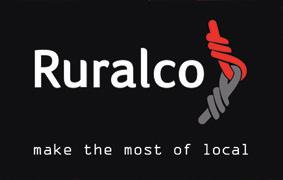
FOLLOWING A HAIR-RAISING ENCOUNTER, BARRY AND PAULINE GEORGE BREATHE A SIGH OF RELIEF, GRATEFUL THEY DIDN’T LEAVE ANYTHING TO FATE WHEN THEY DISCOVERED THEY HAD A NARROW ESCAPE FROM A POTENTIAL DISASTER.
WORDS AND IMAGES SUPPLIED BY FMG INSURANCE
The sheep and beef farmers have a newly built house that Barry helped build so they knew just how solid it was and how little ceiling space it had. But last year they heard some scratching noises in the ceiling which left them baffled.
“We were surprised that anything could have gotten in, we tried hunting around for an entry point, but everything was sealed pretty tight,” Barry says.
“So, we removed some light fixtures and poked some bait in the roof hoping it would solve the problem.”
After a while, it appeared that the problem had been resolved, but a few weeks later, the scratching noises returned, leaving them puzzled about how any critter could still be gaining access.
One day, they observed the garage lights flickering, yet they were oblivious to any connection. Luckily, they decided to call an electrician to investigate the issue.
“The electrician isolated the circuit and said there was something else that needed to be investigated, so started taking some of the walls in the garage down,” Barry says.
“Luckily we knew where the wires were, I didn’t realise how valuable it was at the time but when we were building the house, I took photos of the wiring before the gib went on.”
It didn’t take long for the electrician to find the culprit, a tiny, seemingly harmless mouse had chewed some wires and electrocuted itself. It was very fortunate it hadn’t started a fire.
“There were a few things in the George’s favour,” says Mark Nixon from Couchmans Electrical.
“Being such a new house, it did not have any build-up of easily flammable material that the dead short caused by the chewing mouse could’ve ignited. But if there had been birds nesting nearby, for example, it could’ve been a very different story.”
“The RCD (Residual Current Device) also did what they’re designed to do, it tripped when the fault occurred, isolating the circuit. Ultimately, it was the George’s quick response that had a huge impact, they recognised something was wrong electrically and they got an electrician in to check it out.”
After that wake-up call, they searched the house thoroughly during the day and at night, shining torches to try to see where the mouse may have gotten in. They did find a very tiny hole and plugged it up hoping they have solved the problem completely.
“I used to think Pauline was overreacting when she’d quote statistics about house fires and how easily they can occur,” Barry says.

“But even I got a fright because I can see how easily our mouse encounter could’ve ended very differently.”
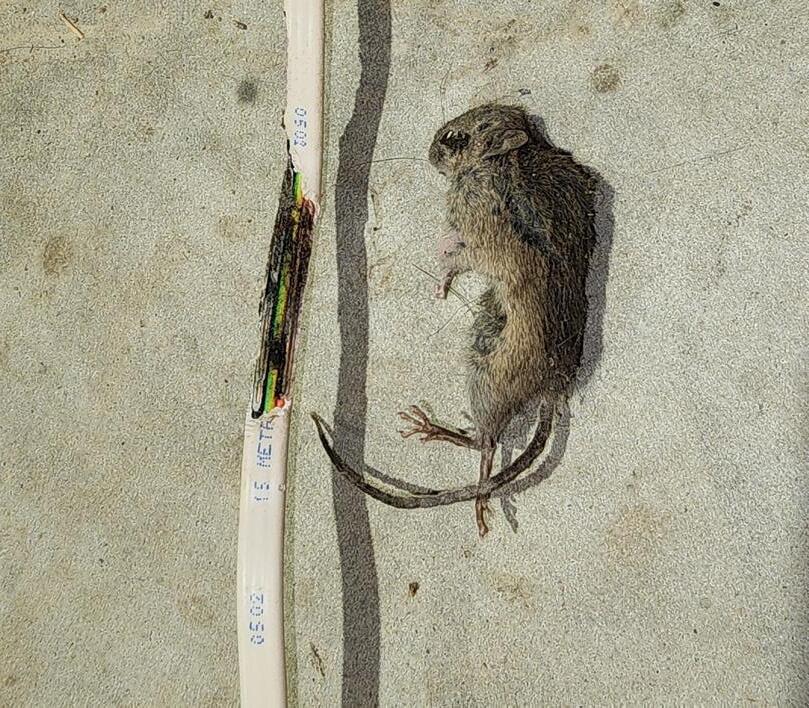
FOCUSING ON DAILY HABITS HELPS MANAGE PRESSURE WHEN THE GOING GETS TOUGH SAYS FARMSTRONG AMBASSADOR SAM WHITELOCK.
WORDS AND IMAGES SUPPLIED BY FARMSTRONG AND FMG
Farmstrong’s all about making your wellbeing a priority in a mentally and physically demanding job. I’ve been its ambassador since 2016 and what I like best about the programme is that it’s so practical. It provides a ‘toolkit’ of things busy people can actually do to increase their wellbeing.
I’ve seen first-hand how well its solutions work for rural people when they choose to adopt them. Last year, over 14,000 attributed an increase in their wellbeing to Farmstrong. Why are farmers and growers making these changes? Because they know to get the best out of your farm or orchard, first, you need to get the best out of yourself. That’s true of any results-driven business, whether you’re a farmer or a rugby player like myself.
The science of wellbeing tells us that people with a strong sense of wellbeing share five simple habits – staying connected with others, keeping the body moving whether it’s gardening, going for a run or bike ride or playing sport, taking time each day to enjoy the simple pleasures rather than focusing on the big picture all the time. We all get busy, and our minds get cluttered with all kinds of stuff, learning new things to stay fresh and giving back to their friends and community.
You could tick them all off by organising one enjoyable activity a week, like coaching kids sport or catching up with your neighbours or getting off farm to go hunting or fishing or attend a community event.
I’ve made the Five Ways part of my life and I encourage you to do the same. They definitely help to provide balance, support, and a sense of perspective when the going gets tough.
We also encourage farmers and growers to look after the basics like getting enough quality sleep, ‘fuelling up’ with the right foods, staying hydrated and scheduling some downtime. When people get busy these things tend to fall by the wayside, but as one farmer told us recently, no one can run a marathon on adrenalin alone.
Whether you’re playing elite sport or farming, it’s important to schedule time to mentally and physically ‘recharge the batteries’.
What the science tells us is that mental health is just like physical health. It can be good or bad. If we think about mental health
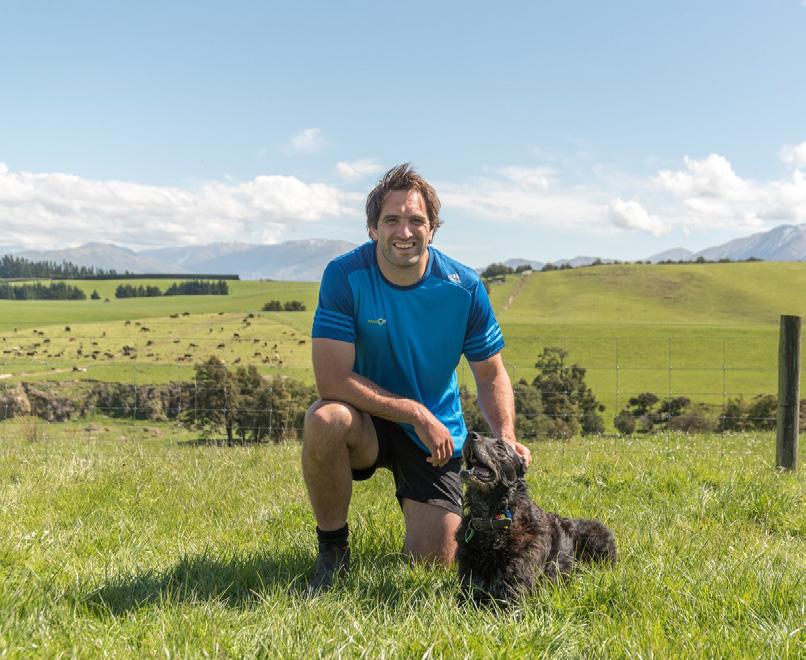
as a continuum from minus five to plus five. Minus one to minus five means people are feeling stressed, anxious, depressed or not coping. That’s where most discussion usually ends and that’s what needs to change.
We need to start focusing on the positive—the zero to plus five—so we start building people’s resilience. Zero to plus five might involve activities such as adopting the 5 Ways, looking after the basics even during busy periods, exploring our mindset and learning flexible thinking strategies so people have the mental fitness to cope with change and pressure.
Farmstrong’s main message is that as individuals and workplaces there is always something within our control that we can do to make today and tomorrow better, no matter how challenging the circumstances might be.
Making regular ‘investments’ in things that boost your wellbeing now means you’ll have something to ‘draw on’ when times are tough.
“ ”
The Five Ways To Wellbeing can make a huge difference to your wellbeing whether you’re a farmer or a professional athlete. Adopting healthy habits has a positive, cumulative effect over time and makes you much more resilient. My message to farmers is find out what works for you and ‘lock it in’.
FARMSTRONG

Unsightly piles of used tyres that occasionally make the news with spectacular and environmentally damaging fires may become a thing of the past once the Tyrewise stewardship programme gets into full swing.
WORDS BY RICHARD RENNIE, IMAGES BY CAMILLA RUTHERFORDThe regulations make being part of the Tyrewise programme a legal requirement for importers, distributors, and retailers of tyres. It comes into play from 1 March, gaining full traction from 1 September
The scheme has been over a decade in the making and was created to develop a means of dealing with the growing problem of New Zealand’s 6.5 million used tyres generated a year. Many end up clogging waterways, or in dangerously stored locations where fire outbreaks are a constant risk.
The programme is based around a tyre stewardship fee, based on a $6.65 excluding GST per equivalent passenger unit (EPU).
An EPU is based on a new standard passenger tyre weighting about 9.5kg and recognises the differences between tyres. For example, a motorbike tyre is .5 of an EPU, while a large truck tyre if 4.2 EPU. The fees are to be clearly disclosed in any invoice, just as GST is.
The scheme is subject to a lead in time between 1 March and 1 September where stewardship fees are collected in advance of the scheme’s operational launch to build up funds.
The fee is for the tyre’s future management, and by September sufficient funds will be in place for the scheme to start regulating and operating, while also building funds to offer incentive payments to processors wanting to develop processing operations to deal with used tyres in a circular manner.
At present only about 40% of end-of-life tyres are recycled in New Zealand, and with support from Tyrewise the extra capacity that exists this is expected to increase to 80% by year four of operation and to 90% by year six.
Ruralco merchant Neumanns Tyres are one of many tyre retailers impacted by the Tyrewise scheme. Emma Hintz of Neumanns has been closely following the development of the Tyrewise programme.
She says it will affect anyone who buys and uses tyres across all types of vehicles, and her business typically deals with many of these, ranging from wheelbarrow tyres through to tyres for large graders and diggers.
“We have already been getting our used tyres collected and ethically disposed of and repurposed, until now it has not been a legal
requirement to do so, but that will change from now on,” she says.
The regulations’ requirement that all participants in the tyre supply chain be registered with Tyrewise and have to abide by a code of practice means the likelihood of illegal stockpiling of tyres will be reduced.
Emma sees the scheme as a programme that will ultimately unlock significant benefits for New Zealand in terms of developing new uses for end-of-life tyres, and reducing the environmental risks such a huge volume of tyres has posed in the past.
“This makes everyone more responsible for the tyres they are buying and using and eventually disposing of. The amount collected from Tyrewise will help develop new uses for old tyres over time.”
Mark Gilbert, the chair of Auto Stewardship
New Zealand tasked with overseeing Tyrewise said old tyres are a valuable resource, and the Tyrewise fee will help stimulate the New Zealand market to make innovative new products from tyres. Overseas uses have included incorporating tyre granules into road surfacing to improve longevity, and extraction of oils from old tyres for industrial use.
For many farmers in Canterbury old tyres are invaluable for helping hold down silage stacks, and Emma says there is no risk they are going to become any less available for that use once Tyrewise kicks off.
“The stewardship fee for recycling the end-oflife tyres has already been paid, and these tyres should always be accessible.”
To learn more about Tyrewise stewardship scheme visit the website: www.tyrewise.co.nz
BELOW: Emma Hintz, Neumanns Tyres







The challenges we face as a nation, with the global population more than 8 billion individuals all needing to be fed, are undeniable.
WORDSSUPPLIED BY
STEPHEN MCNALLY, IRRIGATIONNZ PRINCIPAL TECHNICAL ADVISORProviding safe, nutritious, dependable, and affordable food and drinking water for every New Zealand citizen, as well as making a substantial contribution to the diverse needs of global consumers, is emerging in our conversations with a sense of urgency.
As we confront this challenge, the reality of a discernible impact of all human existence on the land we inhabit becomes increasingly apparent. At the same time, we are becoming more aware of the realities of climate change; whilst the extreme weather events of 2023 leading to catastrophic floods are still top of mind in many communities, so too are the long-term and deeply felt impact of droughts; these must not be overlooked in our collective memory.
Water, the elemental force that has sculpted New Zealand’s landscape for eons, flowing through mountains, valleys, rivers, streams, lakes, wetlands, and the coastline, lies at the heart of a complex policy conundrum.
The rich history of freshwater management in New Zealand is intricately woven into the very fabric of our nation; we have all benefited from hydro energy and irrigated food production.
Water has not only shaped the physical features of our land but has also brought sediments and distributed the nutrients that form the soils we have cultivated for generations. Our agricultural prowess, thriving on abundant water and a climate conducive to farming, has allowed us to prosper as a nation, which is undeniable. New Zealand has diverse landscapes with its unique flora and fauna, also reliant on freshwater. Amid a complex narrative and sometimes emotive headlines, a pivotal question arises: How do we demystify the role of human intervention in these natural systems, especially when the topic of water storage is broached? This opportunity to advance becomes crucial as we look to strike a sensible balance between harnessing the benefits of water for agricultural needs and preserving the environmental, social, and cultural values that makes New Zealand a cherished home for both people and its natural wonders.
Understanding the multifaceted role of water storage and distribution infrastructure in freshwater management is imperative in this context. As we explore the interplay between
storage, distribution, land use change, and the broader functions of freshwater, we need a collective conversation to unravel the complexities at the heart of our nation’s waterrelated challenges.
New Zealand, with its unique geographical features and climatic variations, demands a nuanced approach to water management. The western coastlines, with their natural high and increasing rainfall, stand in stark contrast to the drying conditions to be faced by our eastern productive regions. Recognising the integral role of storage, in maintaining a reliable supply is paramount, as harvesting water where and when it is flowing abundantly, to release it again for distribution when demand is high. Dams, reservoirs, ponds, constructed wetlands, aquifers, rivers, and pipelines are the backbone of this system, working in unison to ensure a steady and reliable water supply.
The importance of a national, regional, and community conversation cannot be overstated as we navigate these challenges. Striking a balance between the various needs of society—ranging from food production to energy, recreation to environmental conservation—requires a collective effort. Viewing the benefits of water storage not in isolation but as an integral part of a broader freshwater management strategy becomes clearer in this collaborative endeavour.
Enabling changes in land use is integral to our agricultural evolution. However, the success of such transformation’s hinges on the certainty and reliability of water supply. This symbiotic relationship between land use change and water availability underscores the need for strategic and tactical water storage to facilitate these shifts.
New Zealand boasts abundant freshwater resources and allocations for consented takes represent only a fraction of the total precipitation. The apparent over-allocation during summer months could be addressed through an extended annual freshwater perspective where storage facilities play a crucial role in smoothing the transition from high rainfall seasons to low precipitation high demand periods.
Navigating the complexities of freshwater management requires a blend of science and practical understanding. An evidence-based approach, grounded in long data sets and trends, should guide our decision-making, steering clear of emotionally charged debates, and mitigating the risk associated with talking about averages and percentages. This is particularly relevant when considering the impact of climate change on precipitation patterns and the availability of freshwater resources while acknowledging the
human elements in planning for where we live and produce our food.
Addressing the multifaceted challenges of freshwater management demands a collective effort. National, regional, and community discussions must converge to form a cohesive strategy. A holistic freshwater strategy is not only essential but encompasses various aspects crucial for our society: food production, drinking water, firefighting, energy production, flood protection, sediment control, and recreational use.
As the strategy trickles down from the national level to regional implementation plans, individuals must actively participate in decision-making. But time is pressing, and we need clear decisions to be made. Enablement, improvement, and adherence to standards—these become the building blocks for achieving the outcomes we collectively desire in freshwater management. The agricultural community stands at the forefront of these changes, necessitating a collaborative effort to ensure sustainable and reliable water access for farming operations while befitting the whole of society with multi-purposed water storage and distribution infrastructure.
Water storage emerges not as a standalone solution but as a sensible and strategic component of a broader freshwater management strategy. By fostering a balanced dialogue and embracing an intergenerational perspective, we can pave the way for a sustainable water future that not only meets the diverse needs of our farming community but ensures the overall well-being of our nation. The dilemma posed by the increasing human population and its impact on our land and water resources is a reality we cannot ignore. The role of water storage in shaping our agricultural landscape and addressing the challenges of freshwater management is both a practical necessity and a nuanced balancing act.
IrrigationNZ is a national membership organisation that looks after the interests of irrigating farmers, growers, and the industry professionals that service them. We actively engage with our members and other stakeholders in the delivery of irrigation best practices and helping shape freshwater policy. Stephen McNally is the Principal Technical Adviser at Irrigation NZ and can be contacted at smcnally@irrigationnz.co.nz.
 STEPHEN MCNALLY PRINCIPAL TECHNICAL ADVISER, IRRIGATION NZ
STEPHEN MCNALLY PRINCIPAL TECHNICAL ADVISER, IRRIGATION NZ
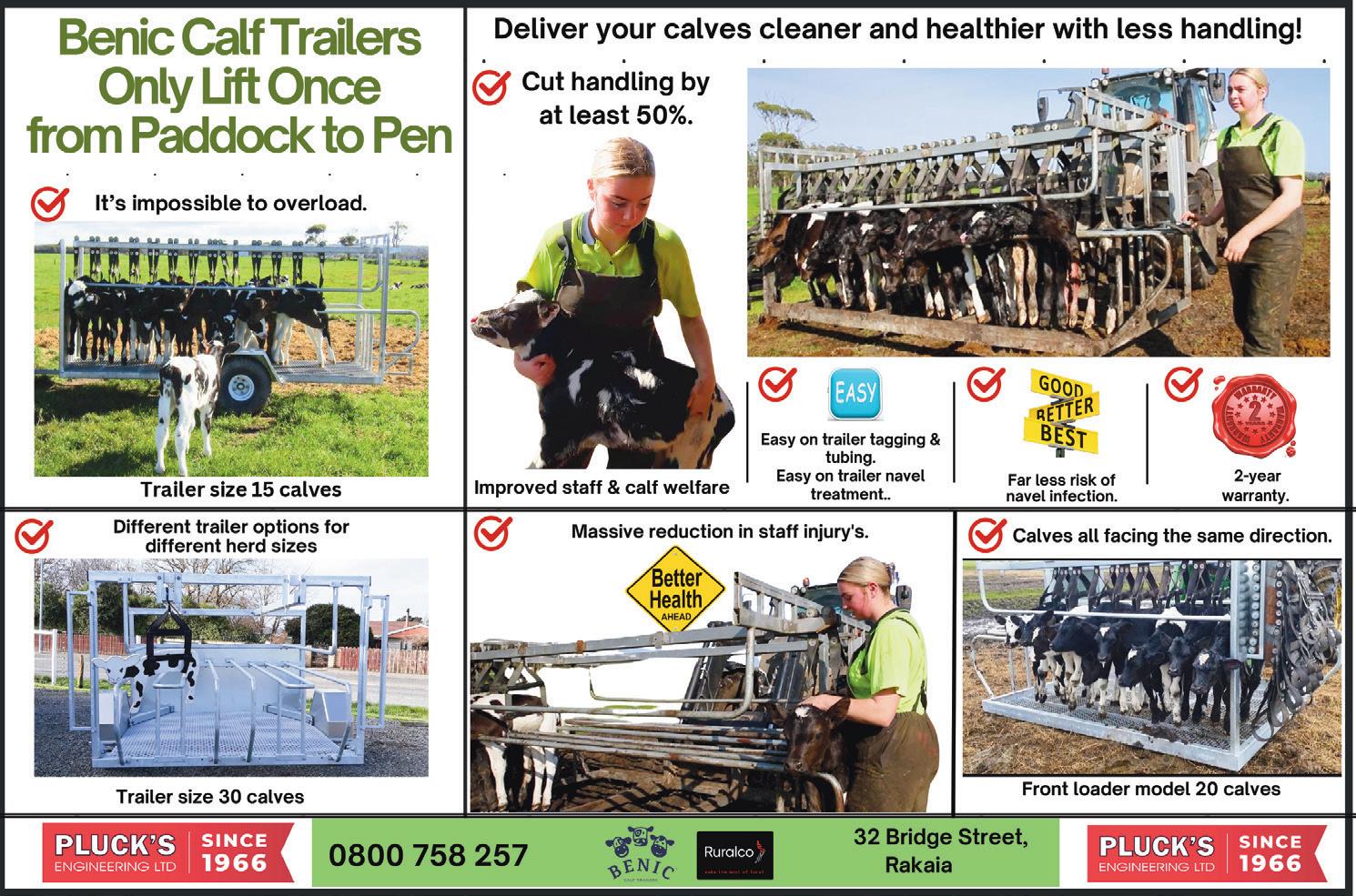




The number of lambs weaned is a driver of profitability on sheep farms and ewe body condition drives both ovulation rates and lamb survival.
WORDS AND IMAGES SUPPLIED BY
BEEF + LAMB NEW ZEALANDSpeaking on the Beef + Lamb New Zealand learning module Sheep Mating Management, farm systems scientist Tom Fraser says to maximise ovulation, ewes should be an optimal body condition score (BCS) of 3–4 going into mating. He says identifying ewes with a sub-optimal body condition (anything under BCS 3) early and giving them high quality feed in the two weeks before mating and throughout the first mating cycle will generate a flushing effect.
Ewes should be on good leafy feed when the rams go out and can gain 0.5–1.0kg in liveweight during the first few weeks of mating if sufficient feed is available.
Flushing after the first 17-day cycle will not benefit lambing percentages.
Where feed is short, silage, brassica crops and grain can be used for feed over the mating period.
To optimise ovulation rates, Wairarapa hill country farmer Rob Thorneycroft flushes his ewes 10 days before the rams go out by giving them priority feed and shifting them either every day or every second day. Speaking on the learning module, he says he aims to put 5kg/ head on his ewes over the mating period.
He also gives lower BCS ewes a mineral drench to cover any trace element deficiencies and when required, an internal parasite treatment before mating. Two-tooths get a pre-mating drench two weeks before the rams go out.
North Canterbury farmers Tom and James Maxwell identify the bottom 10% of their ewes three to four weeks before mating and focus on lifting the condition of those ewes.“They’re the sheep that will always let us down,” says Tom. “We get them on an upward plane [of nutrition] to try and minimise wastage and give them the best chance we can.”
The Maxwell brothers run an A and a B mob over mating. The A mob ewes are put to the maternal sire and the B to the black-face terminal sire.
In their system, any dry hoggets get one chance to lamb as a two-tooth and if they then scan inlamb with a single, they go straight into the B mob. James and Tom are continually identifying the top performing ewes under their management, and these are retained in the A mob. Anything that falls short goes into the B mob.
James says this gives them two good-sized mobs, and as the performance of their ewes has lifted, they have been able to apply more selection pressure and select on attributes such as wool type.
Wairarapa hill country farmer Doug McKenzie runs over 13,000 ewes and this gives him a
good range of age groups. The two and fourtooth ewes are run in one mob, the mixed-age ewes in another and their older six and sevenyear ewes in another. This “Golden Oldies” mob is considered the elite mob because these ewes are proven performers.
The B mob is made up of wet-dries from across all the age groups and any ewes that have been dropped out of the main mob due to constitution, feet or any other fault not bad enough to require culling.
Doug says most of the replacements come from the elite mob with very few coming from the two-tooths as these ewes have yet to prove themselves.
Preparing rams for mating.
Sperm production begins two months before mating so Fraser recommends that the ram team is shorn or crutched and given a vet check at least eight weeks out from mating. This should include a check for trace element deficiencies as a selenium deficiency, for example, can cause sperm defects.
Rams should also be checked for Brucellosis, which can go undetected, and other abnormalities such as missing or deformed testes and scrotal mange.
Foot abscesses in the lead up to mating can cause elevated temperatures and cause infertility for up to two months.
As with ewes, the rams should be given high quality feed in the lead up to mating and go to the ewes at a BCS of 3–3.5.
Recommended ram ratios are 1:150 for mixed-age ewes and rams and 100:1 for mixed-age ewes. For more information visit www.beeflambnz.com
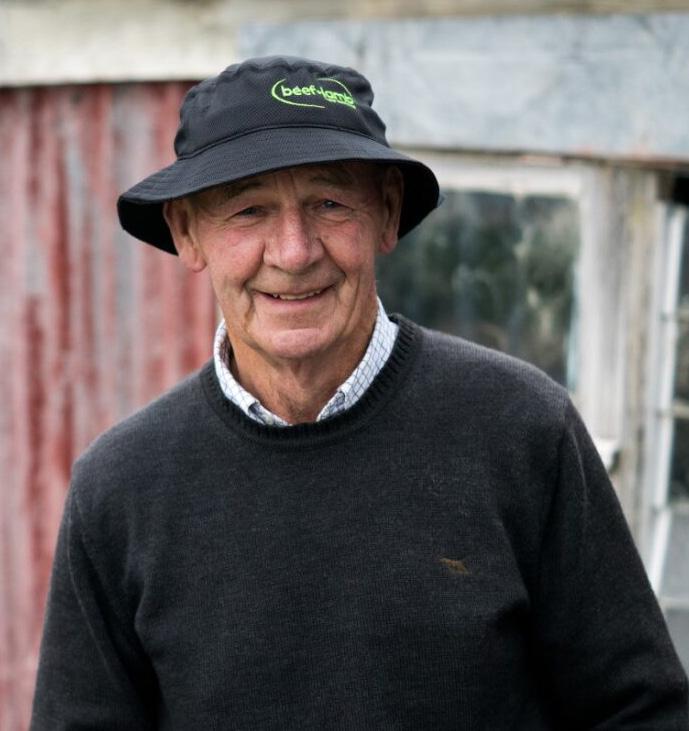


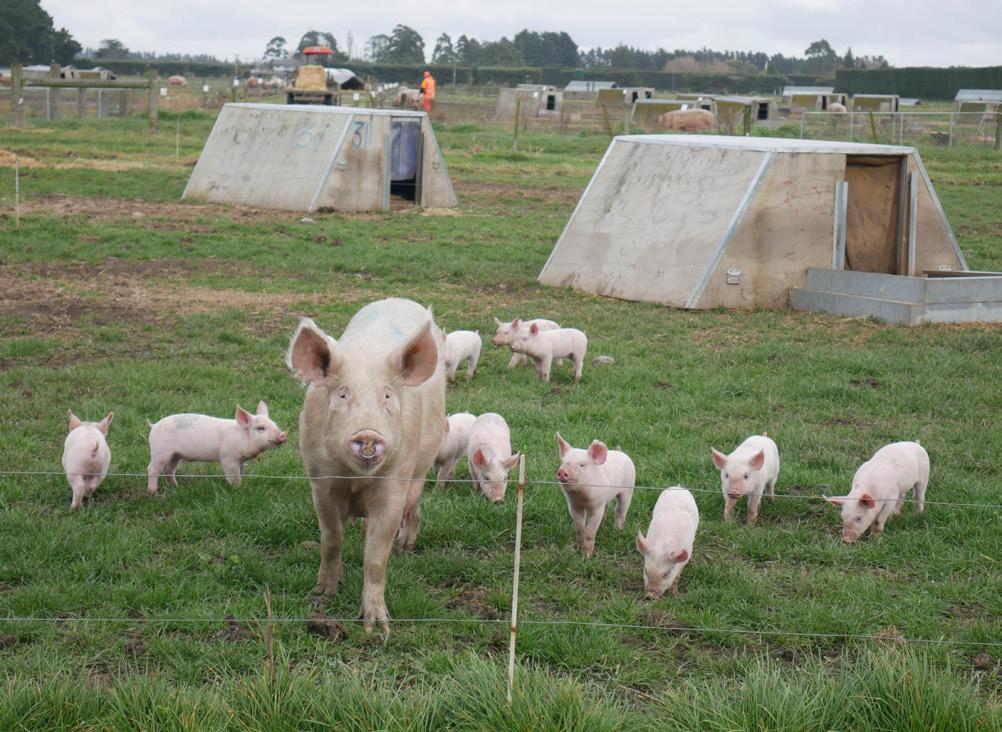
Christchurch Men’s Prison Piggery is not just a producer of premium free-farmed New Zealand pork, it is also a place where men in prison do meaningful work and build new employment and life skills.
WORDS AND IMAGES PROVIDED BY NZ PORK
The 8,000-head piggery covers some 100 hectares of the 800-hectare farm of mixed livestock and cropping that surrounds the prison on the western outskirts of the city. While the farm and piggery are run as commercial businesses, it has a very different focus to normal farms with its workers being prisoners and its staff farm instructors.
“We are not a normal farm and have different goals from your usual farming operation,” Principal Instructor Warren Chilton explains.
“We are primarily about rehabilitation, providing men working and learning on the farm with an opportunity to earn qualifications and learn work aptitudes and skills that will support their future employment in New Zealand’s primary sector, as well as their wellbeing.
“You’re trying to better someone’s life. Very few of our prison farm workers have ever worked on a farm or with animals and many of them take to it well enough to see this as a future career.”
Christchurch Men’s Prison.
A third generation Canterbury pig farmer, Warren decided to take on the role at the prison piggery some 25 years ago at a time when it was a small operation with sows housed indoors. He had always wanted to farm pigs outdoors and the prison farm offered ideal topography with flat, light and free draining soils.
Over the years, the prison pig farm has become one of New Zealand’s largest free-farmed piggeries, with two operations, and finishing the progeny of approximately 900 sows.
It is one of several free farm operations in the country, where the sows are outside, and the growing pigs are housed in eco barns, micro barns and cozy kennels. Most of this accommodation has been built at the prison by men engaged in the Prison’s industry training programmes.
The piggery also has other impressive sustainability credentials. All sawdust for the bedding in the eco barns comes from timber processing, another of the prison’s onsite industry training operations. Once used, it’s turned out onto concrete pads to break down and used in the wider farm’s cropping operations. Likewise, leachate from the compost pads and shed sumps is spread evenly across farm paddocks, protecting groundwater.
IMAGE: Over the years, the prison pig farm has become one of New Zealand’s largest free-farmed piggeries, finishing approximately 900 sows
Pig breeding units are run in rotation to manage accumulated nutrients from pig manure and give the land a break.
“We are pretty proud of what we have done on the piggery over the years,” says Warren. “We have seen an increase in demand for locally grown product as people want to know where their food comes from.”
Warren says pig farms are also audited in New Zealand to very high standards and the prison farm is very proud of both the quality of their product and animal welfare record.
“We are very focused on our goal to train and inspire men in the prison for future roles in agriculture and also to run an environmentally responsible and animal welfare conscious operation.
“At any one time, there are around 16 prisoners working in the piggery where they are trained in NZQA level qualifications, qualifications which are transferrable across the primary sector.”
Prison instructors, who predominantly come from a farming background, are further trained in delivering these qualifications and embedding literacy and numeracy skills into the day to day running of the farm.
Warren says working with animals can also make a massive shift in the men coming from the prison.“We find the demeanour of the men changes on the farm. Animals are very nonjudgemental, they don’t care about how you got where you are—just how you treat them today. So we find they respond well to the men and the men respond well to having an animal to care for. This is the case for all the animals, but especially the pigs which are quite intelligent animals.”
Warren says quite a few of the men go on to employment in the pig industry, to other agriculture roles or to other industries where they are using the work aptitudes of farm labouring and the transferable skills they have learned on the farm.
“It’s always heartwarming to hear the success stories of men who have developed an interest through working and learning in our prison industries and now have a positive and constructive life and employment in the community,” he says.
“Farming is in my blood, and I love seeing how it positively impacts and changes these men and their futures.”
ASHBURTON:
Monday to Friday: 8:00am–5:30pm
Saturday: 9:00am–12:00 noon
Closed on public holidays & Saturdays when the public holiday falls on a Monday or Friday.
RAKAIA:
Monday to Friday: 8:00am–5:30pm
Closed on public holidays.
METHVEN:
Monday to Friday: 8:00am - 5:30pm
Closed on public holidays.
STORE CLOSURES:
EASTER
Our Ashburton, Methven, and Rakaia stores will be closed from Friday, 29 March (Good Friday) to Monday, 1 April (Easter Monday). We will be returning to business as usual on Tuesday, 2 April.
ANZAC DAY
25 APRIL
All Ruralco stores will be closed on Thursday 25 April, returning to business as usual Friday 25 April.
MAYFIELD A&P SHOW
9 MARCH
Join us at the Ruralco marquee at the Mayfield Show Grounds, 218 Arundel Rakaia Gorge Road, for a BBQ and a chat with the team.
METHVEN A&P SHOW
16 MARCH
Join us at the Ruralco marquee at the Methven Show Grounds, 72 Barkers Road, for a BBQ and a chat with the team.
Our latest fencing deals are out now
With competitive pricing on a range of products to support your farming operation.
Shop great deals on farm gates, fencing reels, energizers, poliwire, fault finders, strainers, insulators and more.

Our online freight charges are changing If you purchase products from the Ruralco website, please note our freight charges will be changing.
As of 1 March 2024, all online orders over $150 include free shipping. Online orders under $150 will incur a $14.90 shipping fee.
Save 12¢ on fuel with your Ruralco card
Fill up with Ruralco at selected Mobil and Allied fuel sites across the country and save at least 12 cents per litre off the pump price. Find fuel sites near you at ruralco.co.nz
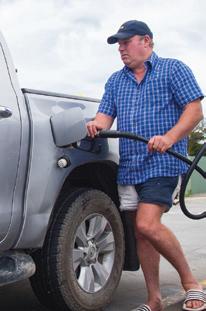
Our BOOST Mineral Blend is a specifically formulated water-soluble, multimineral blend providing essential trace elements for animal health. We can customise the mix to suit your dairy herd’s requirements, delivering it direct to farm.
Talk to your Ruralco representative today to discuss the best mineral mix for your livestock or find out more online at www.ruralco.co.nz/boost
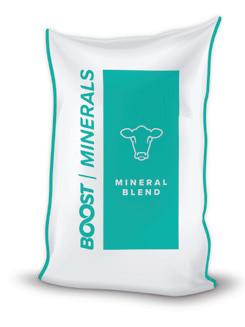
and Ballance
Our partnership with Ballance Agri-Nutrients gives you access to local fertiliser experts that can tailor a solid fertiliser plan to maximise your on-farm production potential. Together we can bring you science-backed and innovative nutrient solutions that will maximise your on-farm production potential delivering a measurable return on investment.
Make the switch to Ballance through Ruralco for all your fertiliser requirements. Talk to your Ruralco representative today.
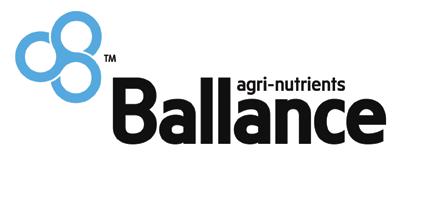
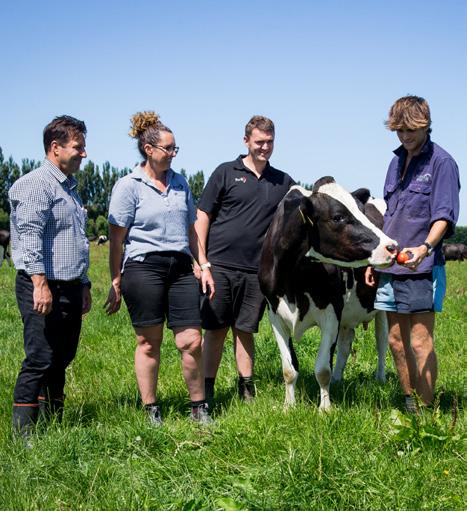
Our extensive product range will ensure you maximise production and performance onfarm. We offer competitive pricing with real value and are here to make your farming life easier. Shop online or in store, and we’ll deliver the right product when you need it.
Talk to one of our friendly Ruralco representatives today. Simply contact us on 0800 787 256, email us, or head into one of our stores in Ashburton, Methven, or Rakaia.
Visit www.ruralco.co.nz/dairy today to see our range of dairy products.

This is just a snapshot of the many great businesses where you can use your Ruralco card and save. Visit www.ruralco.co.nz for a full list of participating businesses near you and discounts available.
Dargaville
Mobil Dargaville
12¢ per litre
Tauranga
Harvey Norman
Tauriko
Up to 15% discount
Whangarei

Rockgas Mid Canterbury
Up to 15% discount
FUEL
The Stable Door
Up to 5% discount
Cave
HOME APPLIANCE & INTERIOR
Mitre 10 Mega Whangarei
Up to 15% discount
SOUTH ISLAND
Ashburton
Liquor Centre
1.5% discount
Peter May
Up to 10% discount
HARDWARE & BUILDING
RESTAURANTS & LIQUOR
CANVAS & UPHOLSTERY
Southern Cross Dog Kennels
Up to 10% discount
Cromwell
Brake & Transmission
Up to 20% discount
Invercargill
Dynamic Maintenance
Up to 5% discount
Kaikoura
Lobster Inn Motor Lodge
Special rates apply
PLUMBING & GAS
ANIMAL FEED
RETAIL
VEHICLE PARTS ENGINEERING & MACHINERY
Rolleston
Brake & Transmission
Up to 20% discount
The Pedal Pusher 7% discount
The Silver Dollar 7% discount
Timaru
New World Convenience
Pro-Adapt Industrial Supplies
Up to 50% discount
Winton
New World Winton Convenience
VEHICLE PARTS
RESTAURANTS & LIQUOR
RESTAURANTS & LIQUOR
SUPERMARKETS & BUTCHERY
ENGINEERING & MACHINERY
SUPERMARKETS & BUTCHERY

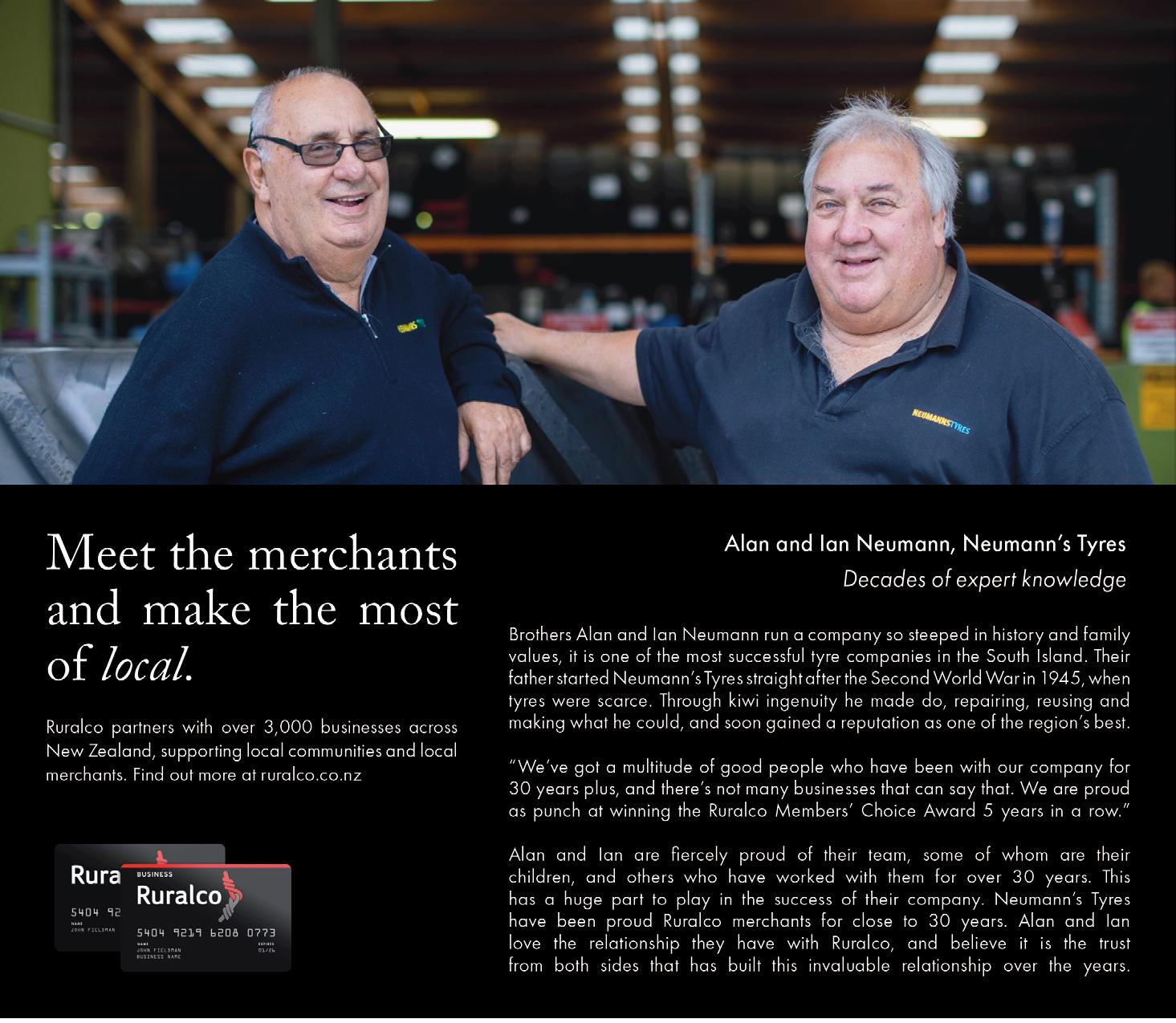







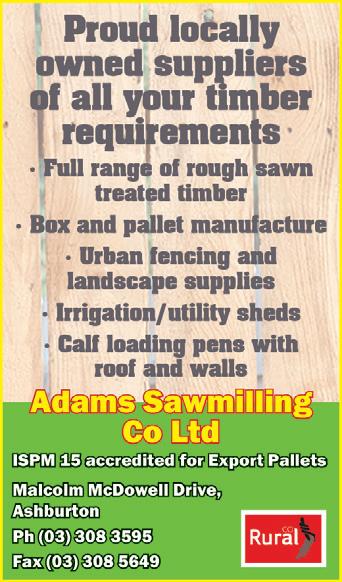


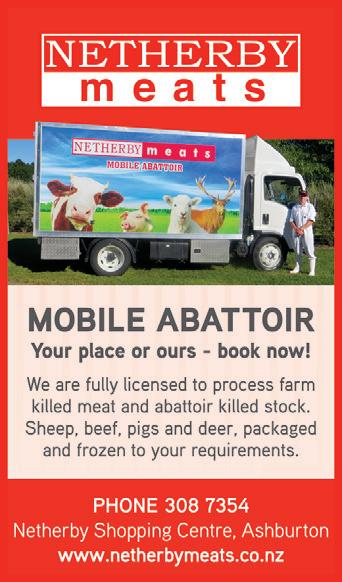







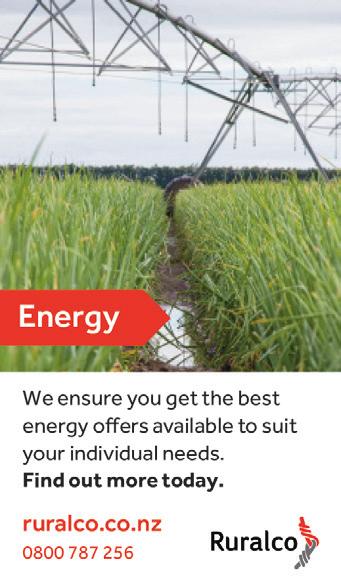














Since then, we’ve achieved a lot together and our vision remains the same.
Our core purpose is offering real value with the latest innovation in farm supplies,
and expert advice to keep your farming business thriving for generations.
In Mid Canterbury, the heart of our homeland, we remain here for you, our farmers.
Our people live in your rural communities so, it’s in our best interest to get it right for your farming business.
Our obsession is agriculture, but our focus is you.

